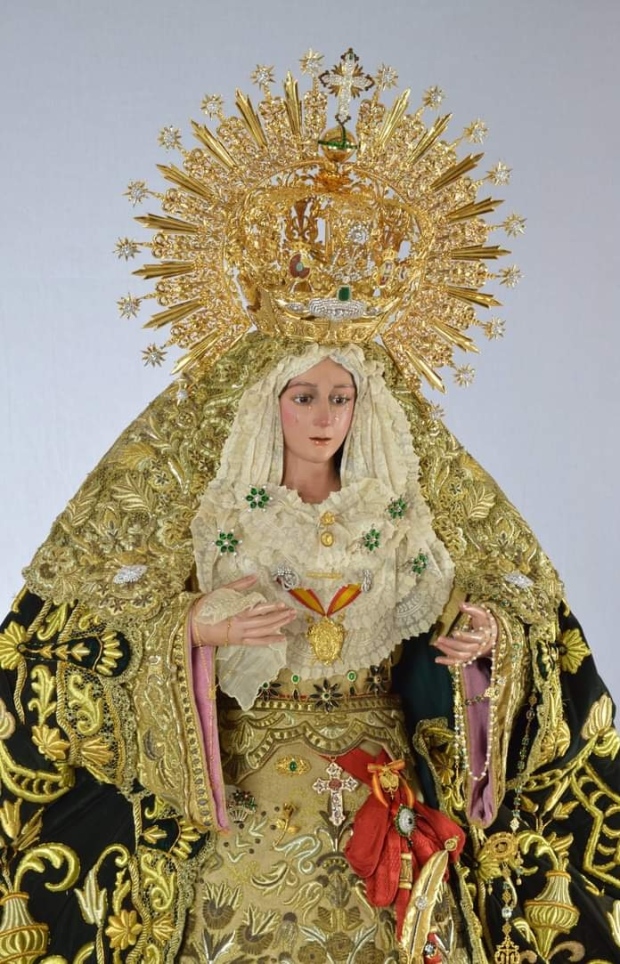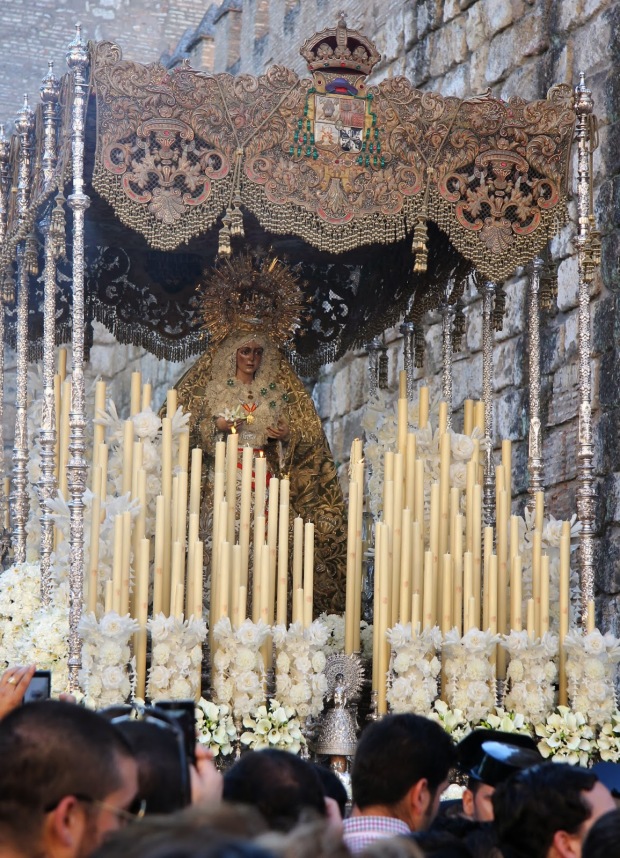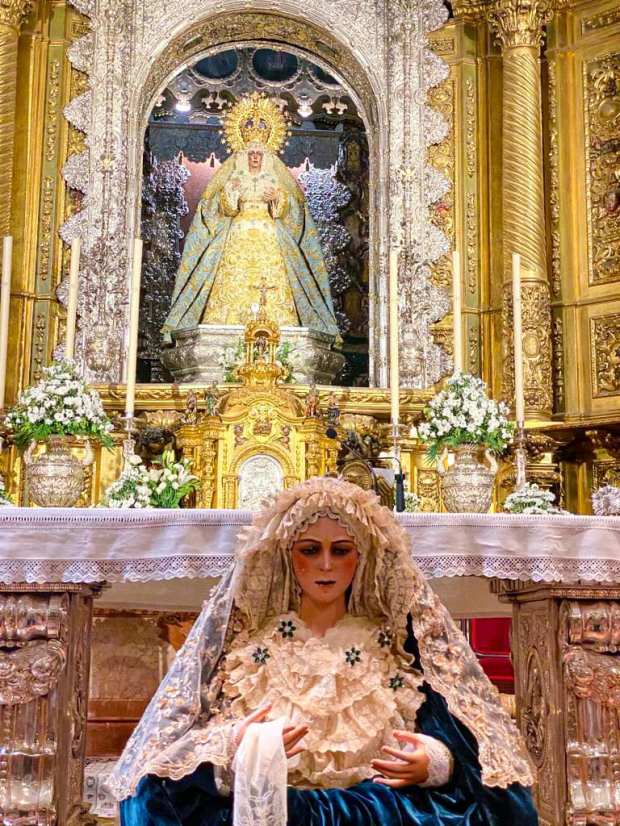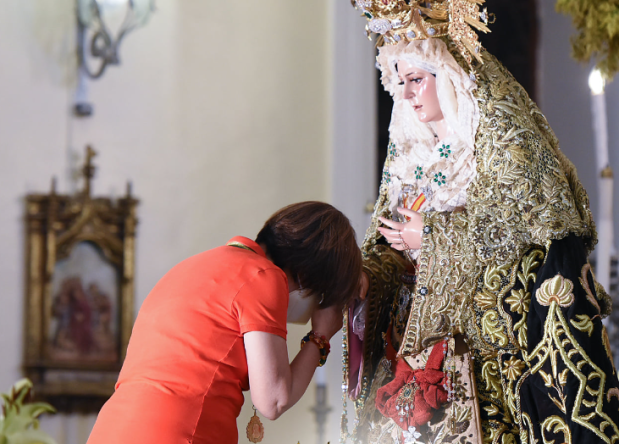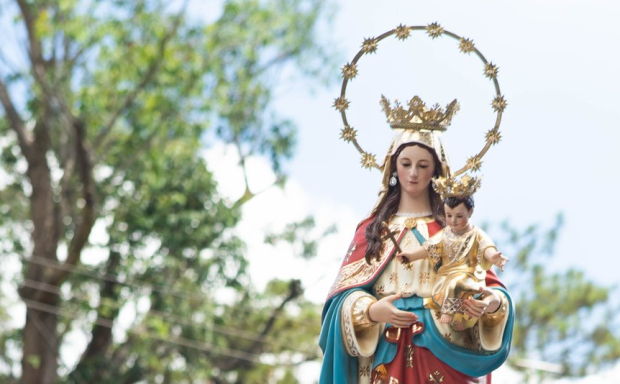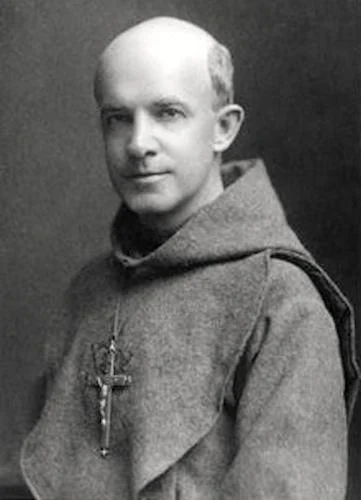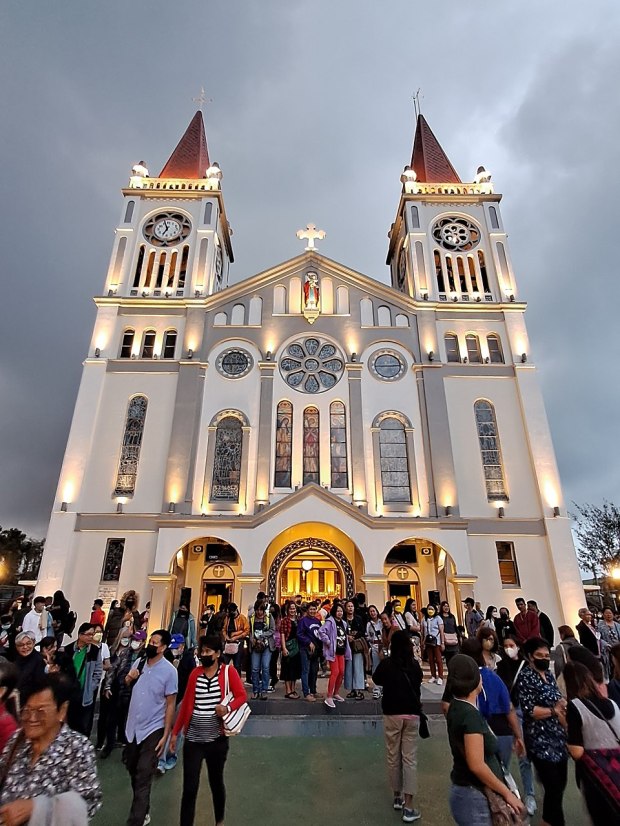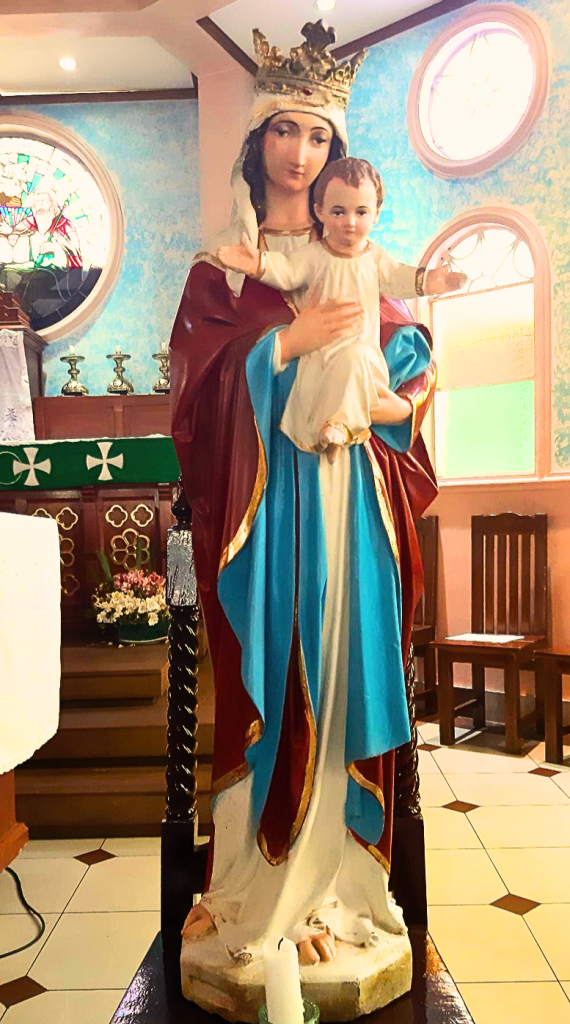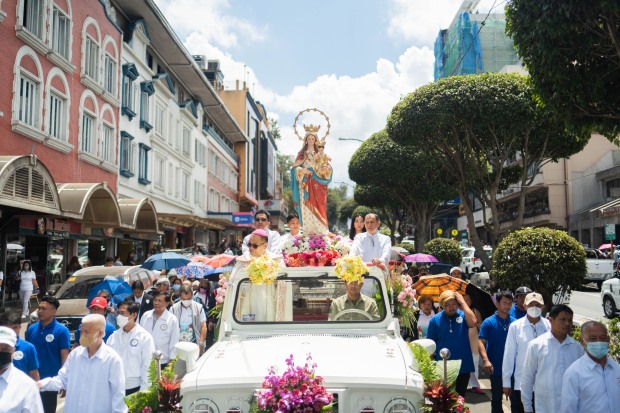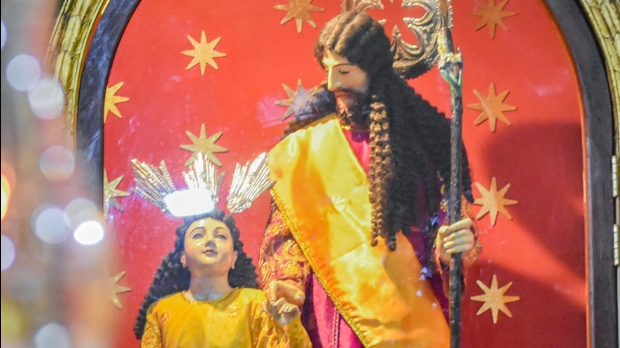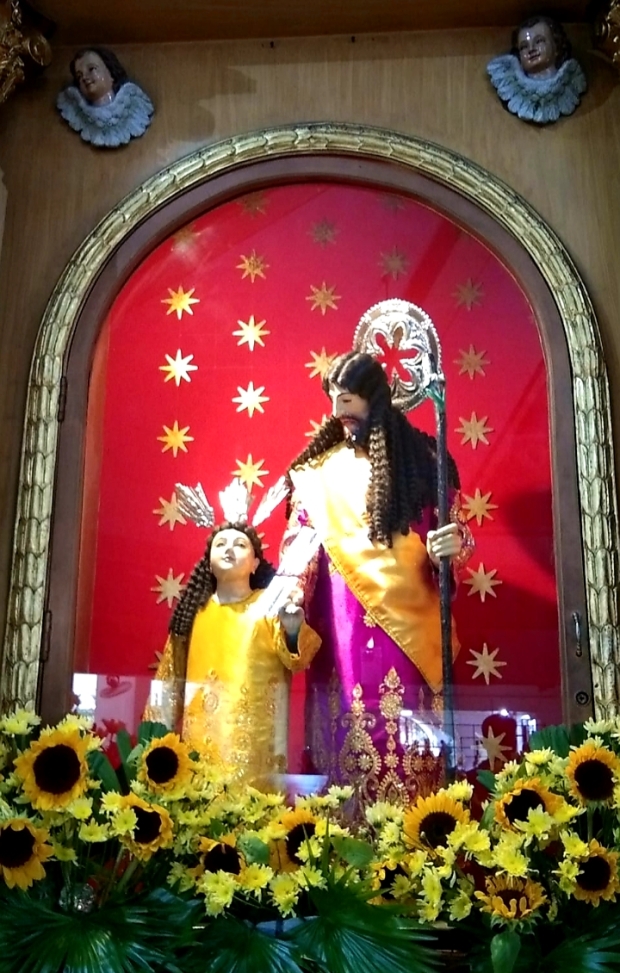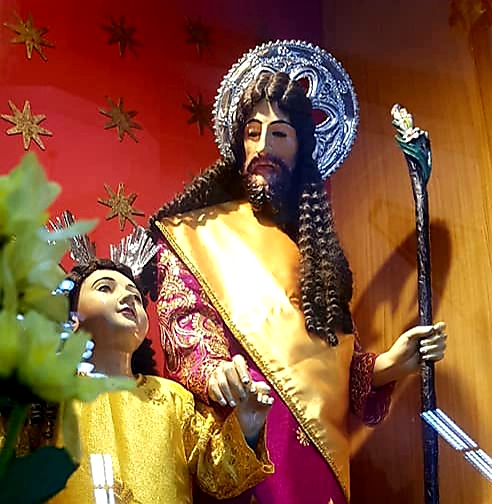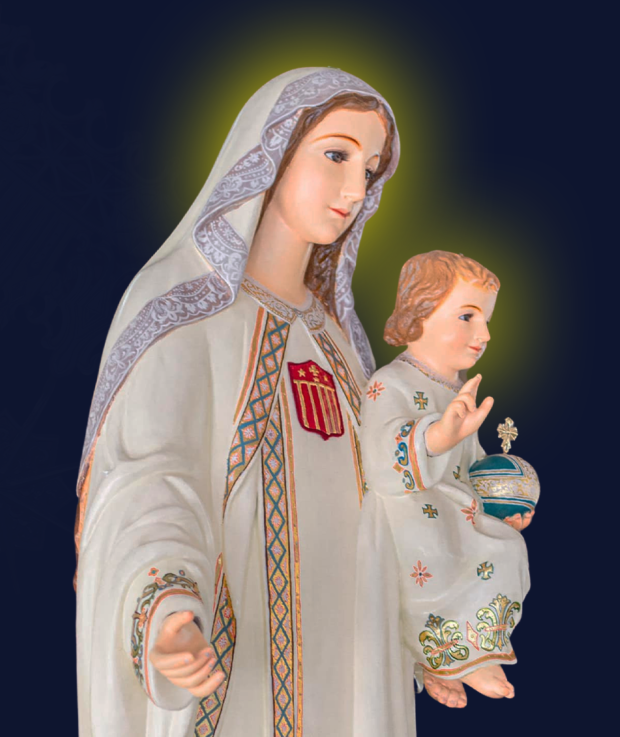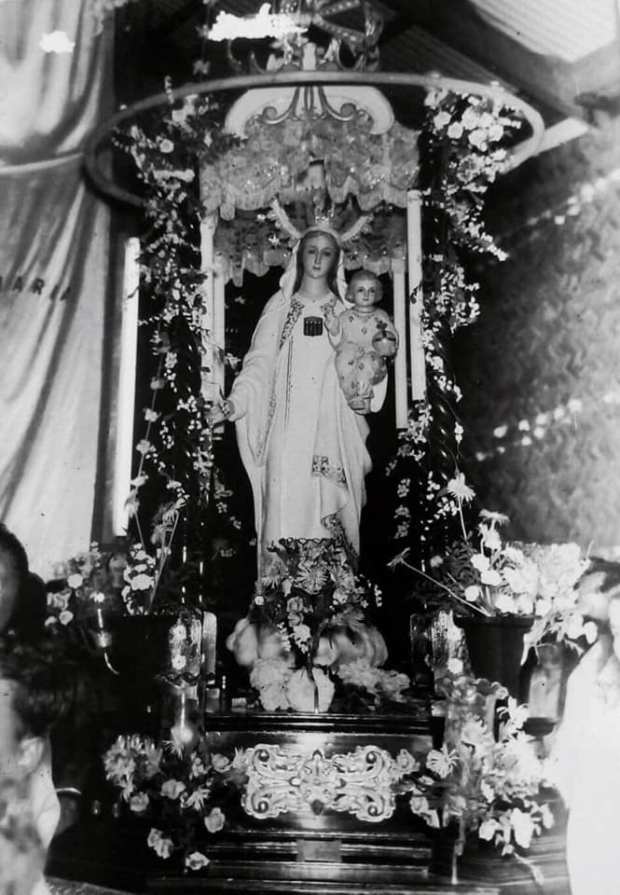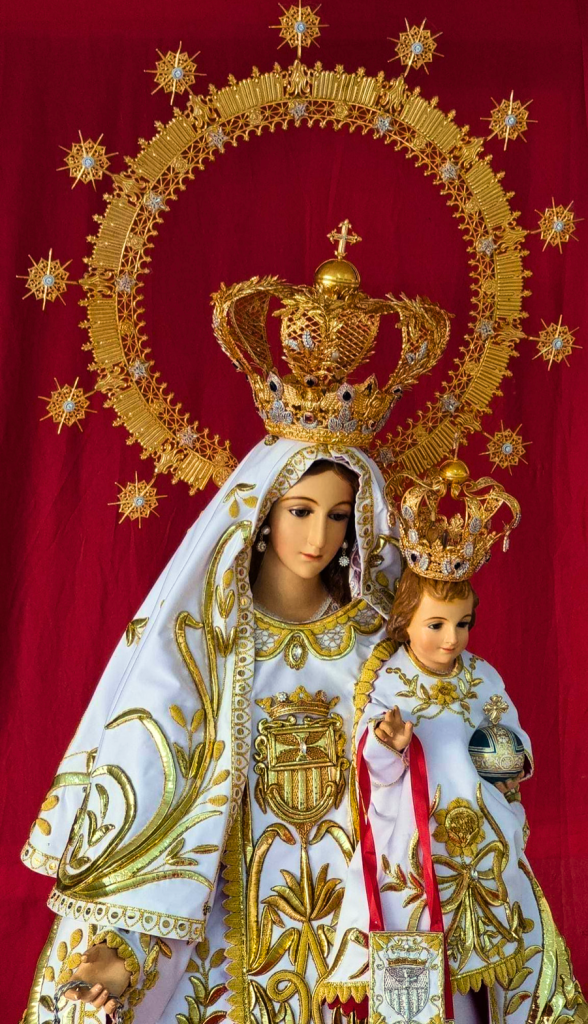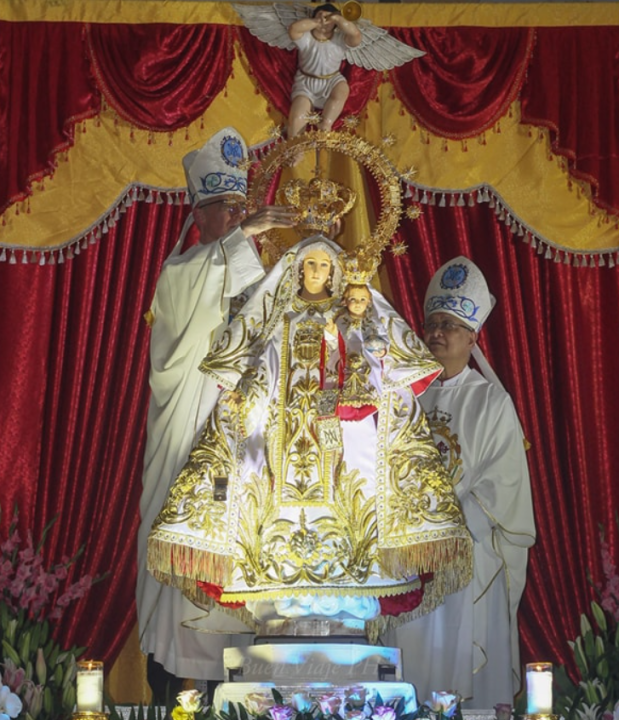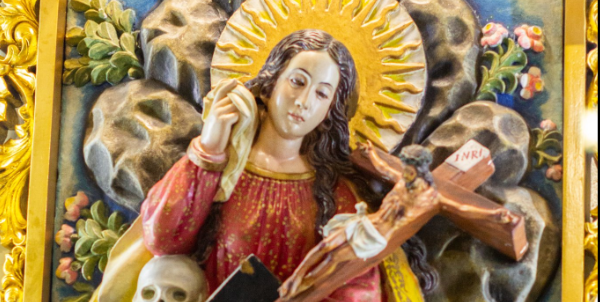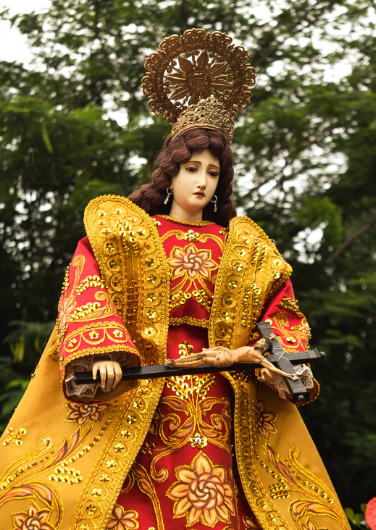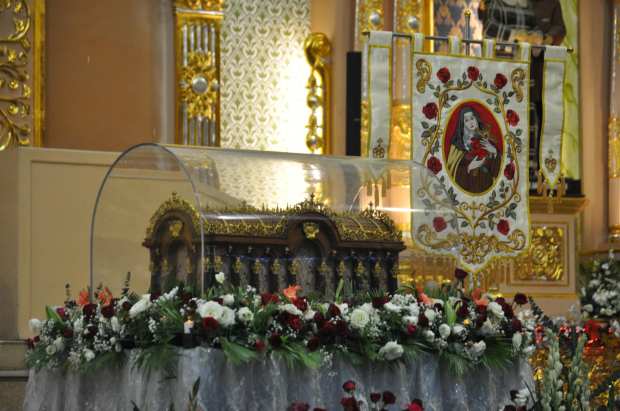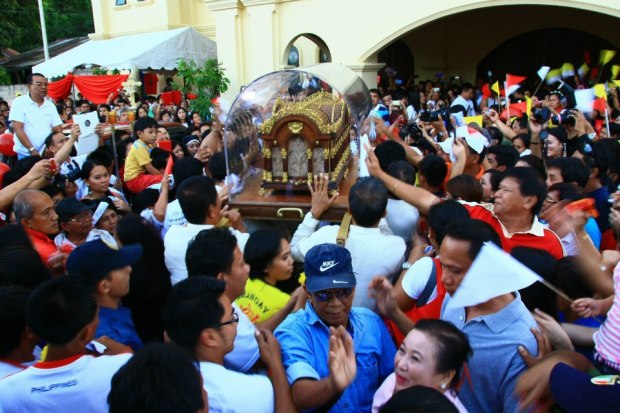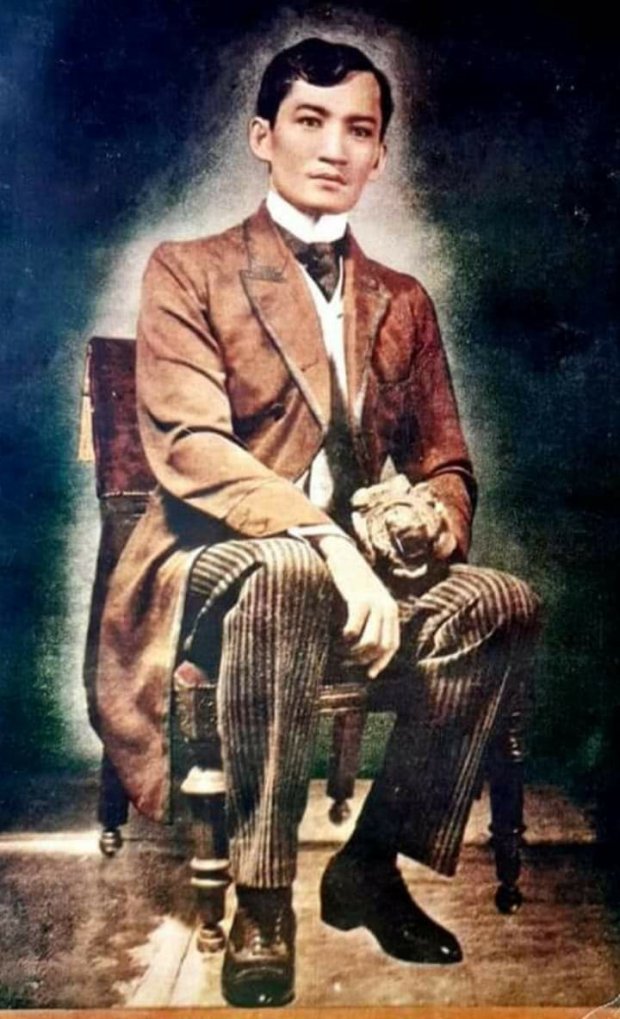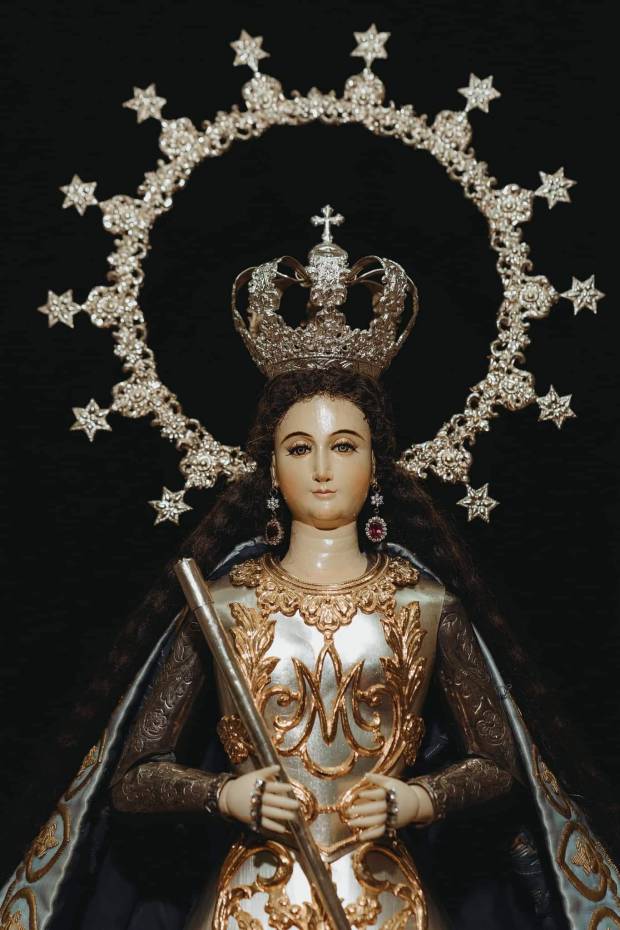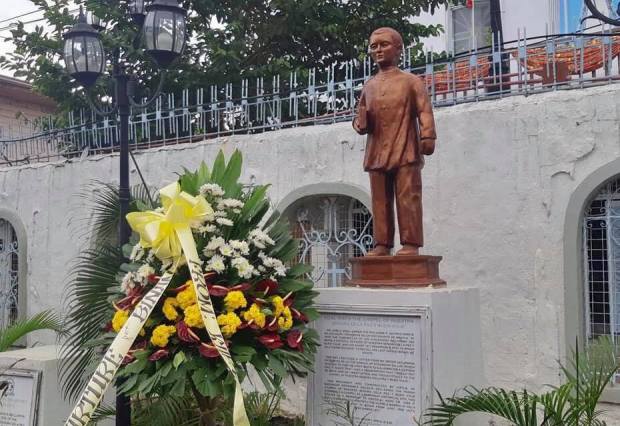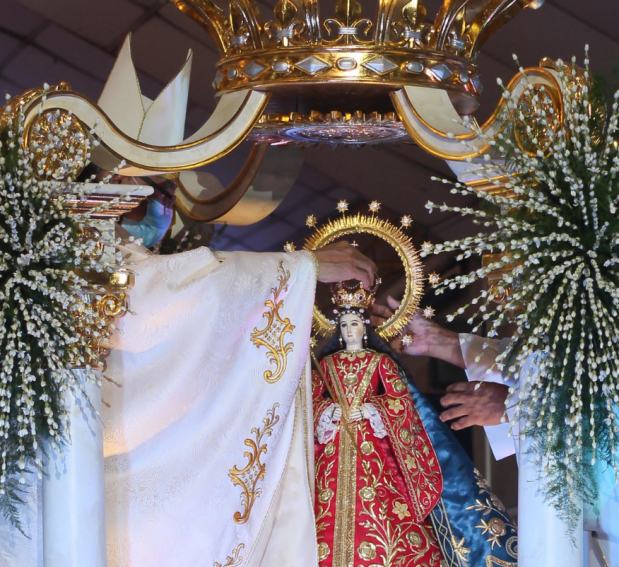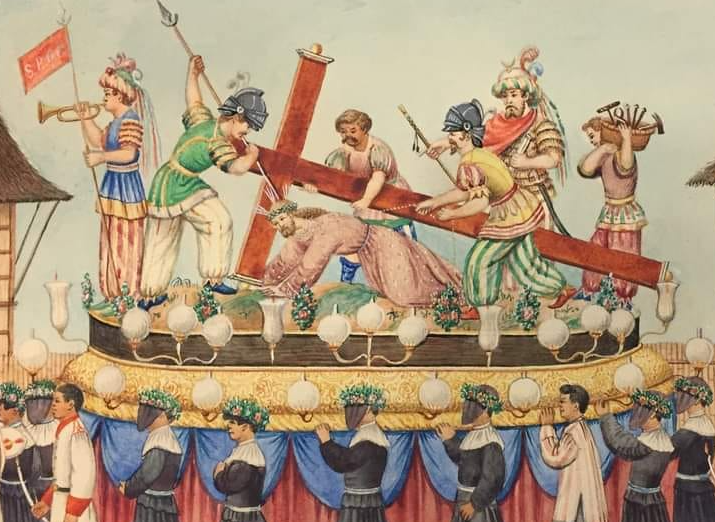
Holy Week in the Philippines is one of the most interesting and colorful religious events in the country because the different practices and devotions from different parts of the country can be seen with their local flavor – a usual sight given the Lenten season’s somber nature. One of the notable of these Holy Week traditions is the processions that are held as early as Holy Monday (even Palm Sunday in some places) and it culminates in the burial procession of Good Friday.
Each city, town, or province has its unique way of holding such processions which adds to the cultural identity of the locale that it became a sight to behold and in some way a tourist and pilgrimage attraction over the years.
For this blog post, we are going to delve deeper into one of the most celebrated and colorful Lenten Tradition in the country that gives off a mix of passion, emotion, pageantry, and evangelization to the onlookers and the faithful alike – the Holy Week processions. We are attempting to trace how the tradition began in Europe and how it arrived and developed in the Philippines along with the evolution of its observance and the current lineup of holy images that are winding the streets in the country during the most somber Liturgical Season in the Liturgical Calendar.
Processions as Catechesis

From the collection of Mr. Luis Sorando Muzás.
The Semana Santa processions [Holy Week processions] have been an important part of Hispanic religious and cultural heritage for centuries. The processions are held during the week leading up to Easter Sunday, and they commemorate the Passion, Death, and Resurrection of Jesus Christ.
The origins of Holy Week processions can be traced back to the Middle Ages when the Church sought to communicate the central themes of the Christian faith to the largely illiterate population. Through the use of images, music, and ritual, the Church aimed to convey the story of Christ’s suffering and sacrifice to the masses.
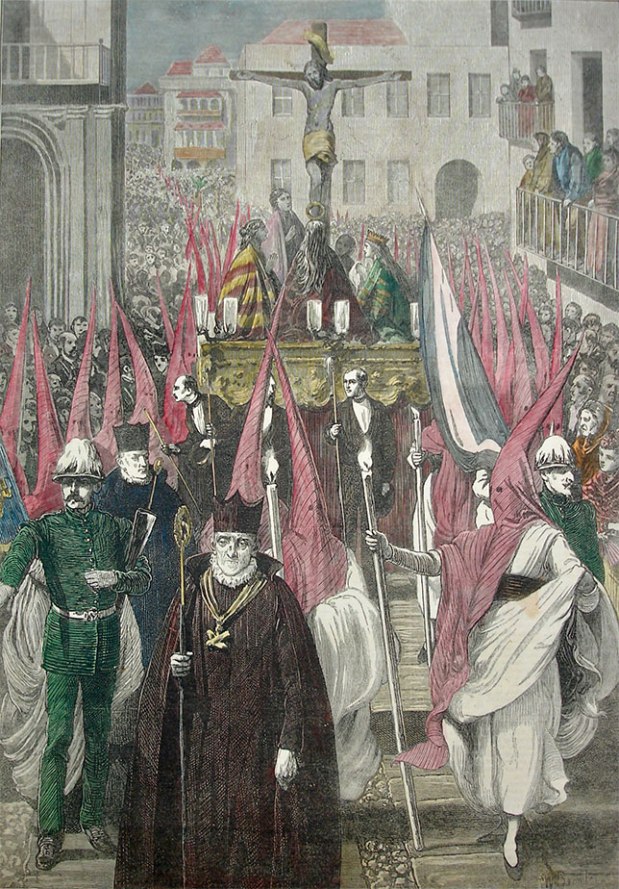
Over time, the Holy Week processions evolved into elaborate displays of artistry and devotion, with each locale in different parts of the world developing its unique traditions and styles. In some areas, the processions are characterized by solemn, silent marches through the streets, while in others they are marked by vibrant displays of color, music, and pageantry.
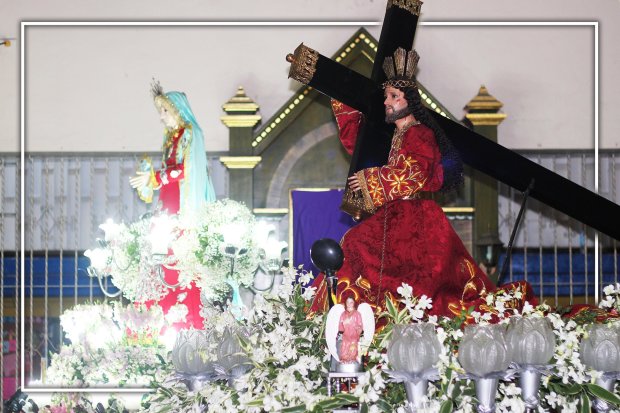
One of the most significant aspects of Holy Week processions is how they bring to life the events of the Passion, Death, and Resurrection of Jesus Christ. Through elaborate displays, tableaux, and reenactments, these processions help to make these events more tangible and real for believers and help them to better understand the significance of Jesus’ sacrifice.
At the same time, Holy Week processions also serve as a powerful meditative tool for many people. As they walk through the streets, often in silence or with solemn music playing, believers can reflect on the meaning of Jesus’ sacrifice and contemplate their own lives in light of his teachings. This can be a deeply spiritual and transformative experience, helping people to deepen their faith and develop a stronger connection to God.
The Holy Week Procession in the Philippines at present

When Christianity was introduced by the Spanish missionaries in our country 500 years ago, the missionaries utilized sacred images to evangelize the natives. One of the earliest known recorded Holy Week processions in the country was documented in Relacion de las Islas Filipinas by Rev. Fr. Pedro Chirino, SJ published in 1606 it described the Holy Week procession in Leyte with a penitential character with the presence of flagellants and penitents.
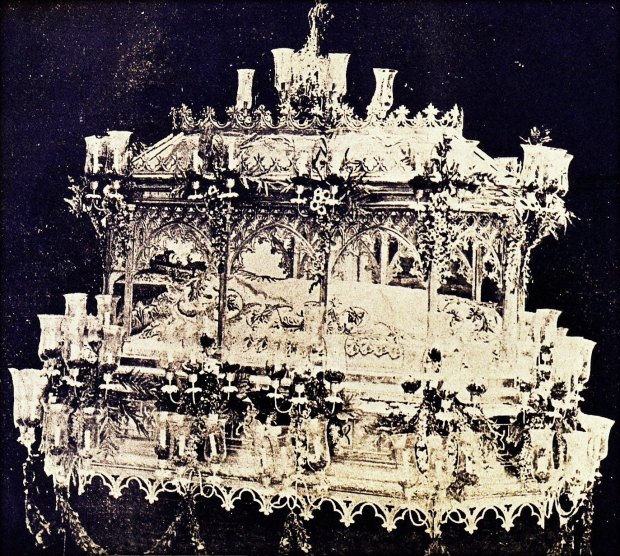
Just like in Spain, confraternities were established to help in organizing Holy Week processions, notable of which were the Cofradia de Nuestro Padre Jesus Nazareno of the Augustinian Recollects and that in San Roque Parish, Cavite City of the same name, and the Hermandad del Santo Entierro y Virgen de la Soledad of the Dominicans. In the Baculo de Parrochos y Ministros of the Franciscans published in 1686, the Franciscans documented the different practices that existed in their mission territories, including the Holy Tuesday Via Crucis procession called Estacion General which featured images of the Jesus Nazareno, Mater Dolorosa, San Juan Evangelista, and Sta. Veronica and the Good Friday funeral procession that is held by sundown with the image of the Santo Entierro.
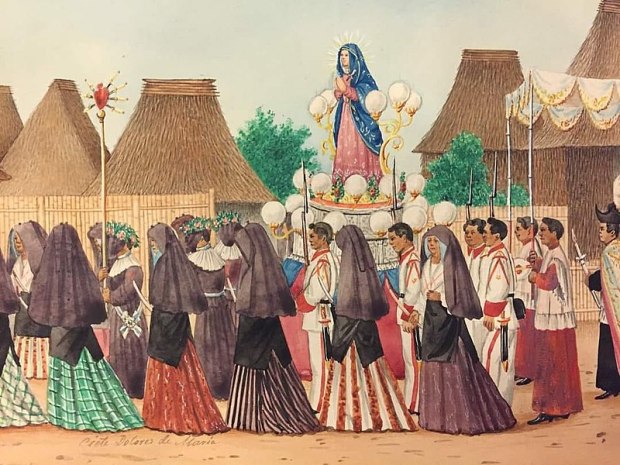
From the collection of Mr. Luis Sorando Muzás.
It was during this time that prominent families were the ones who would help in organizing these processions from the commissioning of images, the decorations for the andas or carroza to be used up to the feeding of the carroza pullers or andas bearers after the procession for the Caridad. It was from this situation that the landed gentry and affluent families would a lot a portion of their land or businesses dedicated and named after the Holy Week Santo or pasos which its income will be used for the expenses needed for the image’s salida (processional outing).
The pasos and Santos that are commissioned during that time were based on Sacred Scripture and Tradition, the Pasyong Mahal, the traditional Via Crucis, and the Mysteries of the Rosary.
As time passed by, the Holy Week processions become more elaborate and at times excessive that synods were held in Manila in 1771 and Calasiao, Pangasinan in 1773 respectively, and the publication of the Manual de Sacerdotes para uso de los parrocos y demas que desempeñan e sagrado ministerio en Filipinas by three Archbishops of Manila to address these concerns and impose regulations to keep the solemnity and penitential character of the Holy Week processions.

Even with the arrival of Protestantism in the Philippines during the American period, the Holy Week processions were not affected and by this time, the Holy Week processions became more widespread as the Aglipayan Church would also stage such processions that can still be seen to this day.
During the Second World War, the Holy Week processions were halted as numerous churches, homes, and towns were destroyed, which includes several Holy Week processional images, and carozzas and the people fled to the mountains to escape. As the War ended, the Filipino faithful painstakingly took their time to revive this beautiful tradition that survived to this present day.

Today, several lay groups and families would still participate and organize Holy Week processions and with the advent of the Internet and Social Media age, paired with economic developments in recent years, owning Holy Week images became possible for the burgeoning working and middle-class and to a younger age demographic that consequently introduced more Holy Week pasos and Santos.
It is during this internet and social media age that the pasos and Santos that are commissioned, apart from the aforementioned traditional sources, more references became more available from the pasos of the Semana Santa processions in Seville and Malaga in Spain, mystical writings of different saints and blesseds, most specifically those of Blessed Anne Catherine Emmerich, that lead to the multiplication of Holy Week santos and pasos in the country.

It is also noticeable in recent years is the inclusion of the other apostles in the procession appeared in recent decades. Although it is a known fact that the remaining 10 apostles hid for their lives during Christ’s Passion as it is recorded in the four canonical Gospels, their martyrdom after Our Lord’s Resurrection merited their share to the Passion of Our Lord Jesus Christ. On the other hand, the presence on the two other Evangelists St. Mark and St. Luke the Evangelist are also noticeable in the modern Holy Week processions in the Philippines to honor them in writing the Passion narrative in their Gospels that we read in the Canonical Scriptures, along with those of St. Matthew the Apostle and St. John the Evangelist.
However, a such dramatic increase of pasos and Santos caused some concerns to the faithful and the clergy due to a lack of research, understanding of the tradition (even on the narrative), unnecessary excess, and commissioning images of saints that are not venerated in the Catholic Church which can lead to heresy. To address this growing concern, some dioceses and scholars issued updated guidelines and books on Holy Week processions to properly guide camareros (image owners/caretakers) and parishes in holding Holy Week processions.

Up to this day, the Holy Week Processions in the Philippines continues to be one of the biggest procession in the country and still holds significance in our culture to this day.
The current Lenten and Holy Week processions formats and when would it start varies on which day it begins as some parishes, shrines, and community chapels would have a Viernes de Dolores Processions in honor of the Our Lady of Sorrows and some would have images of Our Lord entering triumphantly entering Jerusalem on Palm Sunday during the blessing and procession of palms.
In some parts of the country, from Holy Monday up to Holy Wednesday, the Estacion General processions feature different scenes of Our Lord’s Ministry and Passion and Via Crucis Processions, where people visit different altars representing the stages of Jesus’ crucifixion takes place.
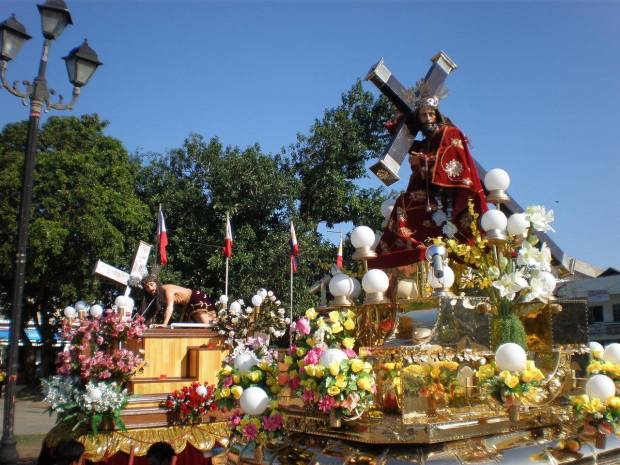
On Good Friday, the most solemn day of the Holy Week, the funeral procession of the Santo Entierro takes place which often features some scenes of the Passion and Saints that were present during the Passion. After the funeral procession, the Procession of the Virgen de la Soledad follows to honor the Blessed Mother in her times of sorrow and solitude after the death and burial of her Son.
There were instances that the Estacion General would also take place on Good Friday due to different circumstances from economic to pastoral reasons to allow the faithful to participate and witness the processions.
The Passion Comes to life
The following images that we are presenting in this blog post are the Holy Week pasos and saints that can be seen in the modern-day Semana Santa Processions all over the country from past to present. The images are arranged based from the manuals and books that are published from different diocese and parishes in the country and books dedicated for pastoral guidance regarding Holy Week Processions.
La Muerte

In some parts of the country like in Cebu, Camarines Norte, Catanduanes and Cavite City, the image of “La Muerte” (Spanish term for “Death”) leads the Good Friday procession. The allegorical image serves as a macabre yet realistic reminder to the faithful of its mortality as the procession continues. The image also shows how death was defeated with the triumph of Our Lord Jesus Christ by His glorious Resurrection and transformed as the beginning of eternal life.
To learn more about the actual purpose of this image and its history, you can check this feature here.
San Marcos Evangelista
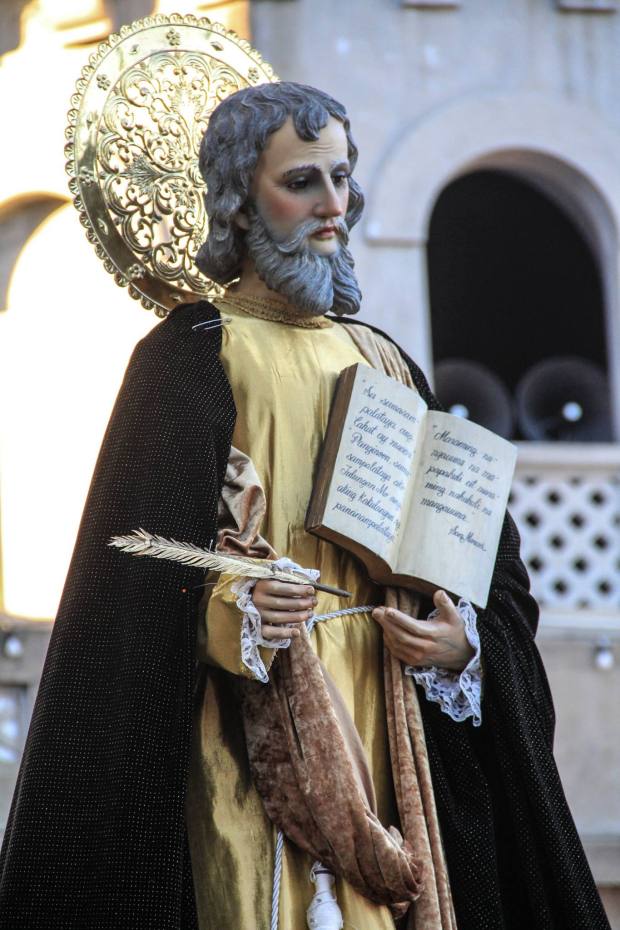
Feast: April 25
Iconography: quill, book, scroll, lion
St. Mark the Evangelist is known as one of the four Gospel writers and is also considered a disciple of Jesus. Among the four canonical Gospels, his Gospel is the shortest and is believed to have been the first one written. He was a follower of Saint Peter the Apostle and accompanied Saint Paul the Apostle on one of his missionary journeys. According to tradition, he preached in Alexandria and was dragged by the people with a rope tied around his neck. His symbol is a lion, as his Gospel begins with John the Baptist preaching and roaring like a lion in the wilderness.
San Lucas Evangelista

Feast: October 18
Iconography: quill, book, scroll, bull
St. Luke the Evangelist, recognized as one of the Gospel writers and a disciple of Jesus, depicted Jesus as a savior for all, including the marginalized. He authored not only the Gospel but also the Acts of the Apostles. Besides being a physician, he was also believed to be an artist, credited with painting several icons of Mary scattered across Europe and Asia. His Gospel opens inside the temple where oxen are offered, leading to the use of the ox as his symbol.
Ang Pagbibinyag kay Hesus
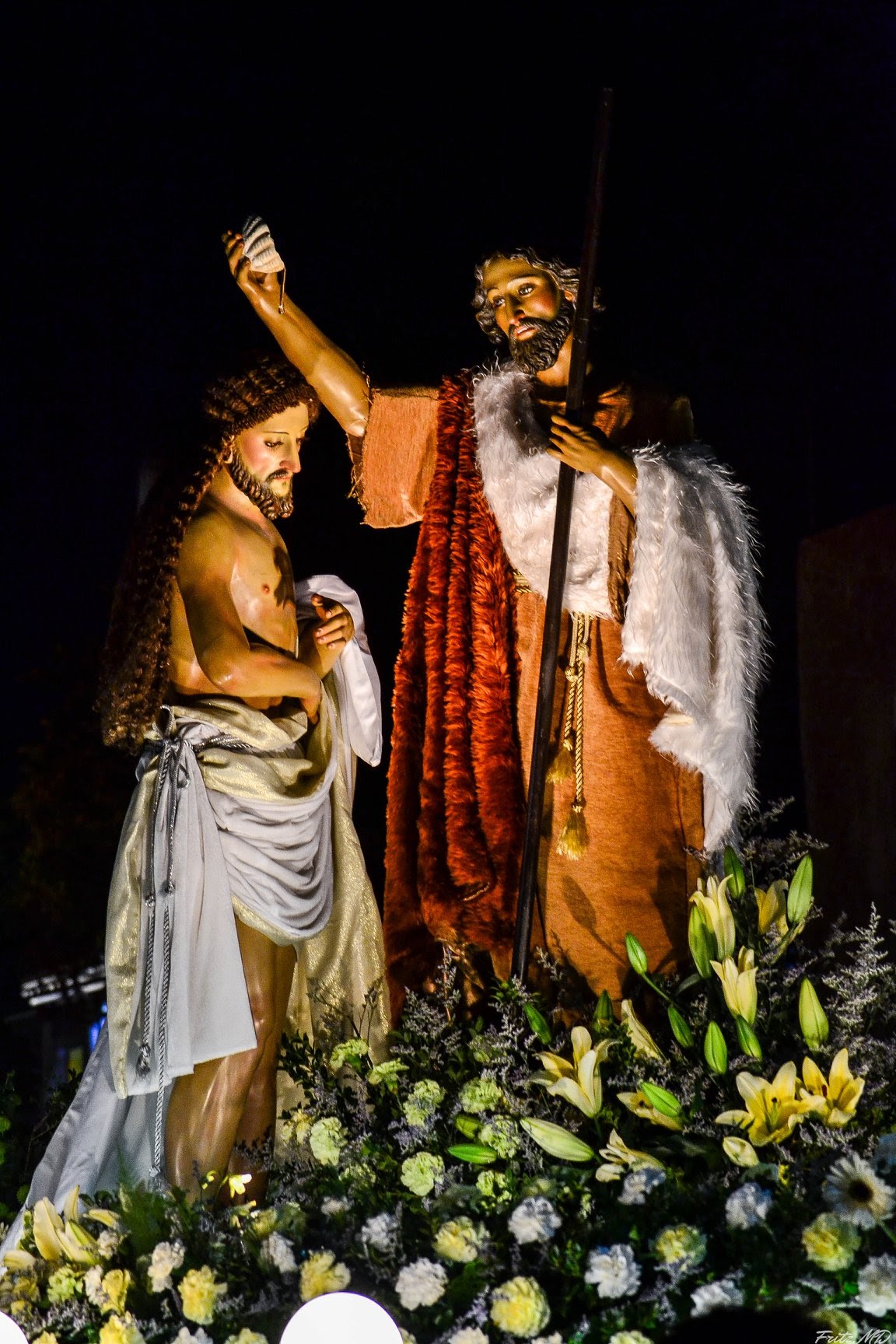
Feast: Sunday after Epiphany of the Lord (Novus Ordo Calendar), January 12 (Traditional Calendar)
The Baptism of Our Lord Jesus Christ at the Jordan River marked the beginning of His public ministry. Jesus asked to be baptized by His cousin St. John the Baptist. As soon as Jesus was baptized, he came up out of the water. Heaven was opened and he saw the spirit of God descending like a dove and alighting on him. Then a voice said from heaven, “This is my Beloved son with whom I am pleased.”
Ang Panunukso kay Hesus sa Disyerto

At that time Jesus was led by the Spirit into the desert to be tempted by the devil. He fasted for forty days and forty nights and afterward was hungry. The tempter approached him to do three things: to make bread in the wilderness, jump from the temple to perform a Messianic sign in the temple, and take the kingdom by force. Throughout His temptation, Jesus maintained His integrity by holding firm against all Satan threw at Him. Because He was tempted as we are, He is able to understand what we face. He is also a powerful example of how to overcome the temptations and testing that comes our way.
This particular episode in the Life of Christ is read every First Sunday of Lent both in the Ordinary and Extraordinary Form of the Mass. The devil in this tableaux can be depicted either in the typical depiction of a demon in art or an allegorical snake (in allusion to the episode of the Fall of Adam and Eve) or a figure dressed in long black attire with a menacing face.
La Samaritana

As Jesus and his disciples are traveling from Jerusalem in the south to Galilee in the north. To make their journey shorter, they take the quickest route, through Samaria. Tired and thirsty, Jesus sat by Jacob’s well while his disciples went to the village of Sychar to buy food. It was about noon, a Samaritan woman came to the well to draw water. During his encounter with the woman at the well, Jesus broke three Jewish customs which shocked the Samaritan woman. Jesus told the woman he could give her “living water” as a gift from God so that she would never thirst again. Jesus used the words living water to refer to eternal life, the gift that would satisfy her soul’s desire. Jesus revealed that he knew her liaisons that got her attention. The two discussed their views on worship, and the woman voiced her belief that the Messiah was coming. Jesus answered, “I who speak to you am He.” As the woman began to grasp the reality of her encounter with Jesus, the disciples returned. Jesus stayed two days, teaching the Samaritan people about the Kingdom of God. When he left, the people told the woman, “… we have heard for ourselves, and we know that this is indeed the savior of the world.” This narrative is read on one Lenten Sundays.
By tradition, the Samaritan Woman is identified as St. Photina. Tradition has it that after her conversion, years later, she was martyred by being thrown into a well. Her name was listed in the old Roman Martyrology on March 20 but later omitted in the current edition.
Ang Pagbabagong anyo sa Bundok Tabor

Feast: August 6
Our Lord Jesus Christ took three of his disciples, Peter, James, and John, up on a mountain to pray. After some time, Moses and Elijah appeared and Jesus was transfigured, his face and clothes becoming dazzlingly bright. Peter suggested building three shelters, one for Jesus, one for Moses, and one for Elijah. He was so terrified he did not know what he was saying. Then a bright cloud enveloped all of them, and from it, a voice said: “This is my beloved Son, with whom I am well pleased; listen to him.” (Matthew 17:5, NIV) The disciples fell to the ground, paralyzed with fear, but when they looked up, only Jesus was present, returned to his normal appearance. He told them not to be afraid. On the way down the mountain, Jesus commanded his three followers not to speak of the vision to anyone until he had risen from the dead.
Ang pabubuhay kay San Lazaro

The Gospel of St. John notes that Jesus loved Lazarus and his sisters and that when Lazarus died of illness, Jesus wept and was “greatly disturbed.” Although Lazarus had been entombed for four days by the time Jesus arrived at Bethany, he was raised by Jesus from the dead and emerged from the tomb wearing his burial cloths. This miracle, witnessed by many Jews who had come to grieve with the family, inspired many to believe in Jesus as the Christ.
San Lazaro de Betania

Feast: July 29
Iconography: Crozier, book, sheets of white cloth
St. Lazarus of Bethany, the sibling of Martha and Mary, resided in Bethany, a place near Jerusalem. He was famously resurrected by Our Lord Jesus Christ, but there is no mention of his life after this event in the New Testament. Nevertheless, various traditions have survived. According to one such tradition, Lazarus, along with his sisters, Martha and Mary, traveled to France where he became the first bishop of Marseilles before being martyred. In other accounts, Lazarus and his sisters journeyed to Cyprus where he became the bishop of Kition or Lamaka. Another legend claims that he went to Syria.
La Despedida

This touching scene was not recorded in the Scriptures, yet it is handed over by tradition and through writings from numerous mystics from their mystical visions on the Life of Christ. It is said that Our Lord Jesus Christ says farewell to his mother Mary, before leaving for his final journey to Jerusalem, which he knows will lead to his Passion and death; indeed this scene marks the beginning of his Passion. The scene can be often seen in Passion plays, religious art, and processions.
Ang pagpasok ni Hesus sa Jerusalem

On the Sunday before his death, Jesus began his trip to Jerusalem, knowing that soon he would lay down his life for our sins. Nearing the village of Bethphage, he sent two of his disciples ahead, telling them to look for a donkey and its unbroken colt. The disciples were instructed to untie the animals and bring them to him. Then Jesus sat on the young donkey and slowly, humbly, made his triumphal entry into Jerusalem, fulfilling the ancient prophecy in Zechariah 9:9: “Rejoice greatly, O Daughter of Zion! Shout, Daughter of Jerusalem! See, your king comes to you, righteous and having salvation, gentle and riding on a donkey, on a colt, the foal of a donkey.” The crowds welcomed him by waving palm branches in the air and shouting, “Hosanna to the Son of David! Blessed is he who comes in the name of the Lord! Hosanna in the highest!”
This image of Our Lord on a donkey holding a palm often appears during Palm Sunday Rites either enshrined at the parish or in procession with the priest for the blessing and procession of palms and the Estacion General processions.
Ang Pagtangis ni Hesus (Dominus Flevit)
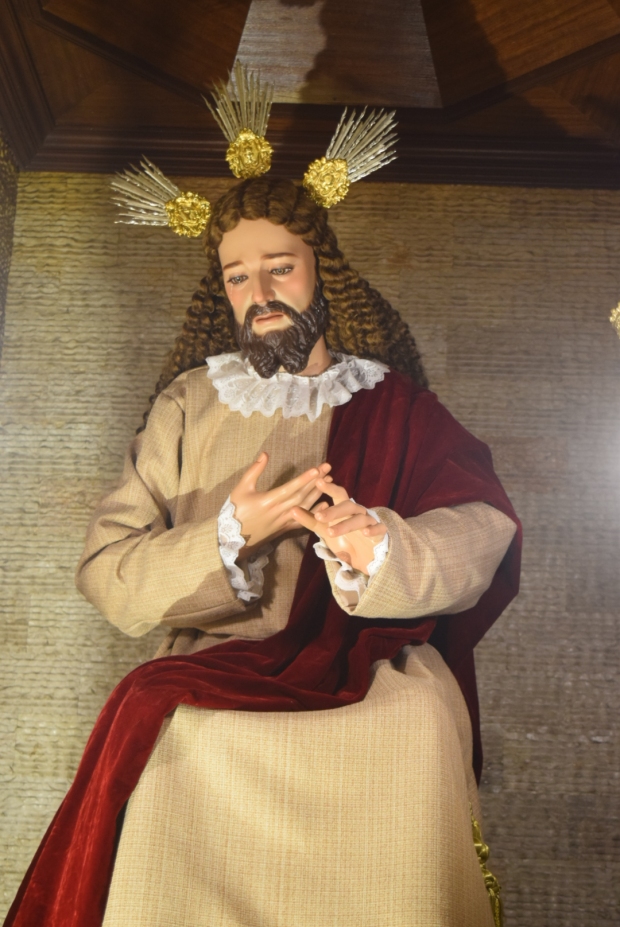
After Jesus goes down the road of the Mount of Olives, He then began to descend into the Valley of Kidron where He had a panoramic view of the entire city. As He looked down on the city, He burst into tears. Jesus shed tears over the spiritual blindness of the people of Jerusalem and mourned for the future he foresaw for the city, which included suffering and slaughter under Roman rule.
A Church was built in the Holy Land on the place where it is believed where He wept for Jerusalem.
Ang paghuhugas ng paa sa Panginoong Hesukristo
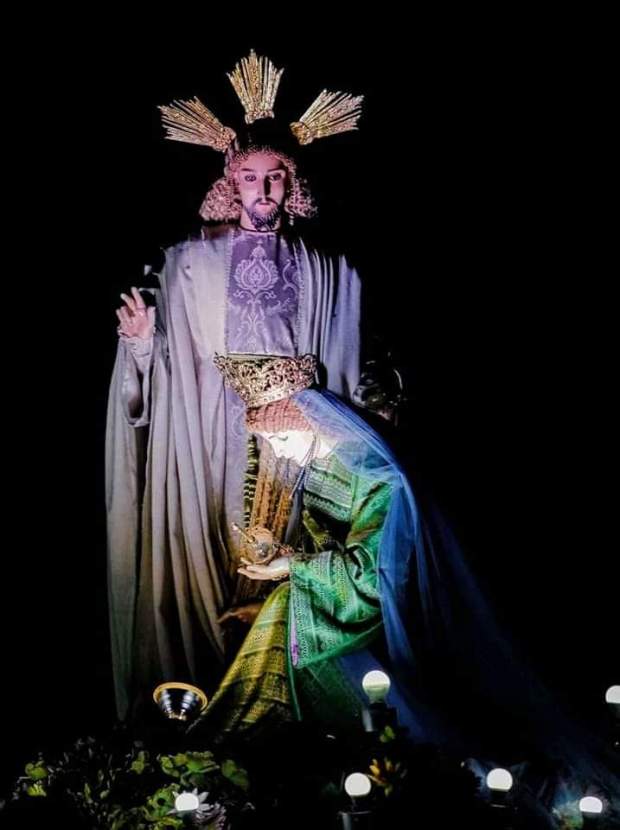
While Jesus was in Bethany in the home of Simon the Leper, St. Mary of Bethany came to him with an alabaster jar of very expensive perfume, which she poured on his head as he was reclining at the table. Mary laid her woman’s honor at the feet of Jesus. She used her hair as a towel to wipe Jesus’ feet. When the disciples saw this, Judas Iscariot was indignant. “Why this waste?” they asked. “This perfume could have been sold at a high price and the money given to the poor.” Aware of this, Jesus said to them, “Why are you bothering this woman? She has done a beautiful thing to me. The poor you will always have with you, but you will not always have me.” In St. Matthew and St. Mark’s Gospel accounts, they emphasize the prophetic significance of the anointing of Jesus, alluding to His death and burial. There may also be an implication of Jesus’ kingship, since, in the Old Testament, the anointing of the head was often associated with the dedication of kings.
Ang Paglilinis ni Hesus sa Templo ng Herusalem
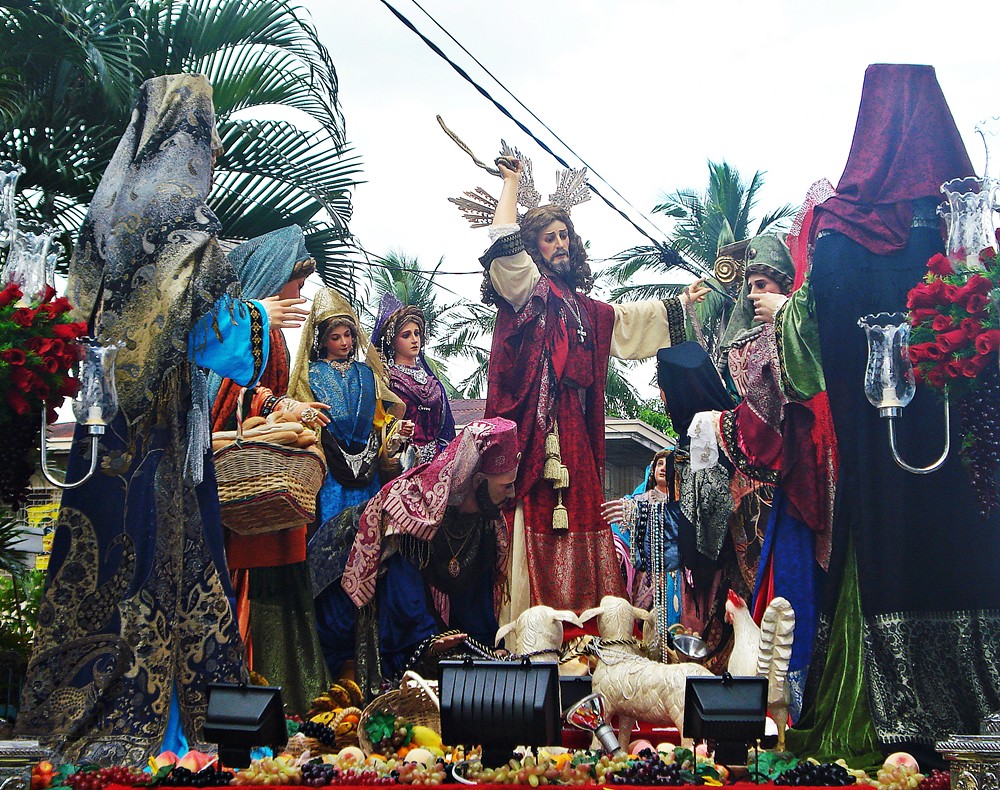
Jesus Christ and his disciples journeyed to Jerusalem to celebrate the feast of Passover. They found the sacred city of God overflowing with thousands of pilgrims and saw money changers, along with merchants who were selling animals for sacrifice. Pilgrims carried coins from their hometowns, most bearing the images of Roman emperors or Greek gods, which Temple authorities considered idolatrous. Jesus was so filled with anger at the desecration of the holy place turning it into “a den of thieves” and “a house of trade” that he took some cords and wove them into a small whip. He ran about, knocking over the tables of the money changers, spilling coins on the ground. He drove the exchangers out of the area, along with the men selling pigeons and cattle. As he cleansed the Temple of greed and profit, Jesus quoted from Isaiah 56:7: “My house shall be called a house of prayer, but you make it a den of robbers.” (Matthew 21:13) The common people were impressed by Jesus’ teaching, but the chief priests and scribes feared him because of his popularity. They began to plot a way to destroy Jesus.
Ang Paghuhgas ng Paa ni Hesus sa mga Apostoles
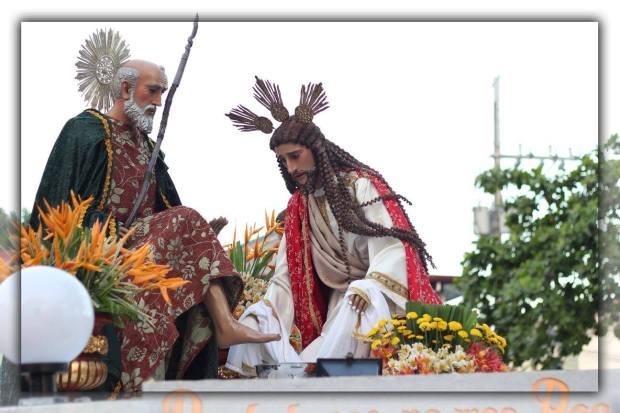
From Bethany, Jesus sent Peter and John ahead to the Upper Room in Jerusalem to make the preparations for the Passover Feast. That evening after sunset, Jesus washed the feet of his disciples as they prepared to share in the Passover. By performing this humble act of service, Jesus demonstrated by example how believers should love one another. Today, many churches practice foot-washing ceremonies as a part of the Maundy Thursday liturgy.
Ang Huling Hapunan
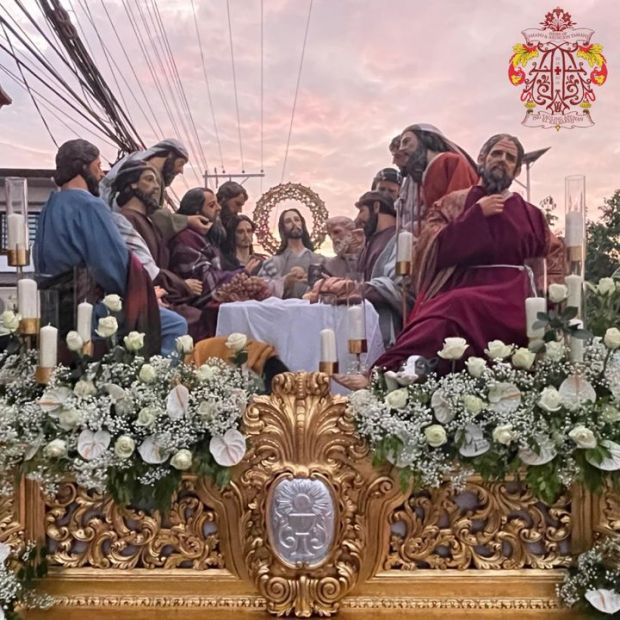
The Last Supper is the meal that Jesus shared with his disciples after his triumphant entry into Jerusalem during the Passover. As the Lamb of God, Jesus was about to fulfill the meaning of Passover by giving his body to be broken and his blood to be shed in sacrifice, freeing us from sin and death. He established the Sacrament of the Holy Eucharist, instructing his followers to continually remember his sacrifice by sharing in the elements of bread and wine. At that same supper, Jesus announces that one of his disciples will betray him. After they finished eating, He told His Apostles that they should love one another as He had loved them. If they did this, people would know they were His disciples. He said that if the Apostles loved Him, they would keep His commandments. He promised them the gift of the Holy Spirit.
Santa Maria, Ina ni Juan Marcos

Feast: June 29
Iconography: Chalice and Keys
St. Mary, Mother of John Mark (also known as Mary of Jerusalem or of Cyprus), was a follower of Jesus and is considered to be the mother of Saint Mark the Evangelist. According to a popular belief, she was the proprietor of the house where the Last Supper was held and where the Holy Spirit descended. In the Acts of the Apostles, it is mentioned that Peter visited her house after being released from prison by an angel. Her name was listed in the old Roman Martyrology, but it was later removed during the revisions made in light of the Second Vatican Council.
San Pedro Apostol
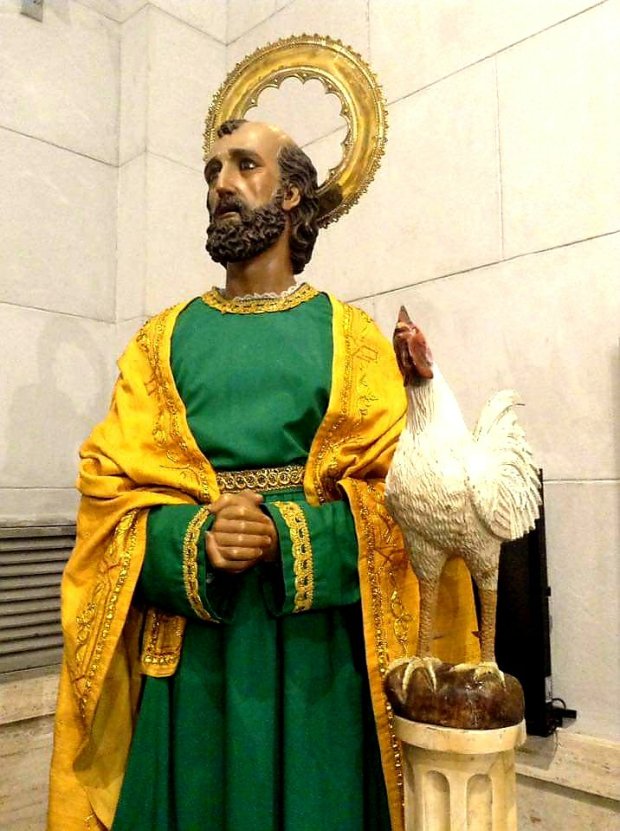
Feasts: June 29 (Solemnity), February 22 – The Chair of St. Peter, August 1 – St. Peter in chains (Traditional Calendar)
Iconography: Rooster, keys
St. Peter, who is also known as Simon Peter of Cephas, is commonly recognized as the leader of Jesus’ twelve Apostles and the initial bishop of Rome. When Peter met Jesus, he immediately recognized Him as the Messiah. Likewise, Jesus knew from the start that Peter would be the foundation of the Church. Peter was present at significant events in Christ’s public life, along with two other apostles. He is often depicted beside a rooster, which symbolizes his three-time denial of Jesus before the rooster crowed. After the Resurrection, Jesus gave Peter three chances to profess his love and loyalty, thereby counterbalancing his previous denials. It was then that Jesus confirmed Peter as the leader of the Church. Consequently, Peter became the first Pope in an uninterrupted line of Catholic Church leaders. He was martyred in Rome, specifically at Vatican Hill, which is now the site of St. Peter’s Basilica.
Traditionally, the image of St. Peter comes first in the Holy Week Processions, especially on Good Friday. Although it may not be historically accurate, his repentance embodies the spirit of Lent that invites the people to reflect.
Santiago Mayor
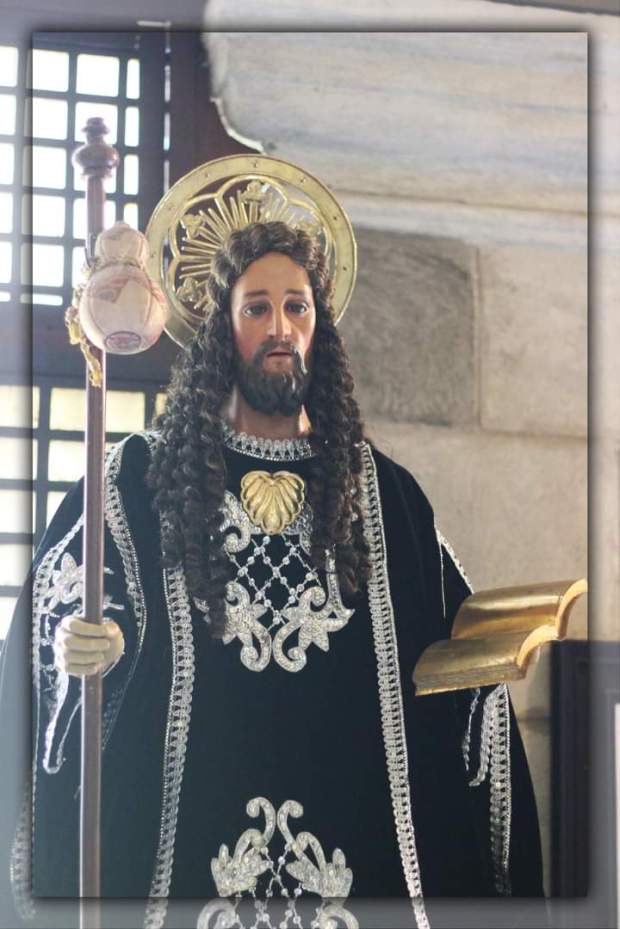
Feast: July 25
Iconography: Scallop
St. James, who was the son of Zebedee and the brother of John, is sometimes referred to as “Great” or “Elder” to differentiate him from the other apostle named James. He was among the three apostles who were present at three significant events – the raising of Jairus’ daughter, the transfiguration, and the agony in the garden. According to tradition, he preached the Gospel in Spain and was visited by the Blessed Virgin Mary as Our Lady of the Pillar. James was the first apostle to be martyred, and his martyrdom is the only one recorded in the Bible. He is usually depicted wearing a scallop necklace and holding a staff with a gourd water container, which are symbols of pilgrims, as his shrine in Santiago de Compostela in Spain is a renowned pilgrimage destination.
Santiago Menor

Feast: May 3 (May 1 in the Traditional Calendar)
Iconography: Club, a book or scroll
St. James, who was the son of Alpheus and one of the twelve apostles of Jesus, is referred to as “Less” or “Younger” to distinguish him from the other James. Although he is rarely mentioned in the Gospels, he wrote a letter that is now included in the Bible. In this letter, he emphasizes that faith without works is essentially dead. According to tradition, James was killed by being hurled from a tower and then clubbed to death. He is often depicted carrying a book or scroll because of the epistle he authored in the Bible.
San Felipe

Feast: May 3 (May 1 in the Traditional Calendar)
Iconography: Cross, bread
Saint Philip the Apostle was among the twelve disciples of Christ, and he is known for his role in asking Jesus how to feed the 5,000 and to reveal the Father, which prompted Jesus to explain that He and the Father are one. Like his fellow apostles, Philip preached the Gospel and ultimately met a martyr’s death, having been crucified. Interestingly, Philip is also revered as the patron saint of pastry chefs.
San Andres
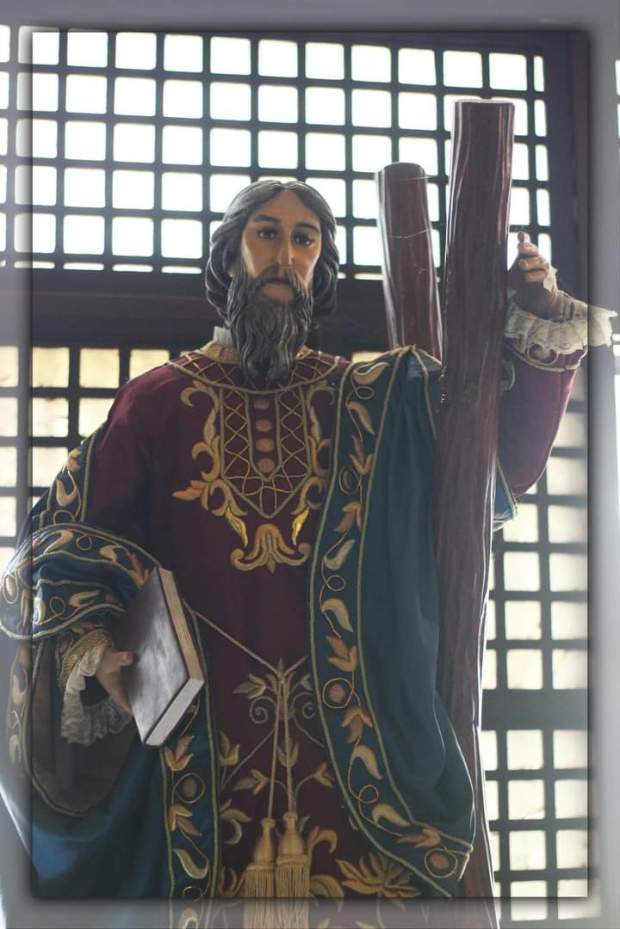
Feast: November 30
Iconography: fish, x-shaped cross
St. Andrew was a member of the original twelve apostles of Christ and was referred to as the “Protokletos” or “First to be Called.” He was the brother of St. Peter and famously provided the fish and loaves for the feeding of the multitude. According to tradition, he was imprisoned for preaching the Gospel and ultimately met his death by crucifixion on an x-shaped cross. Even as he hung on the cross, he preached the word of God for three days straight without interruption. St. Andrew is venerated as the patron saint of fishermen, and interestingly, also of those with sore throats and the Patron of Manila.
Santo Tomas
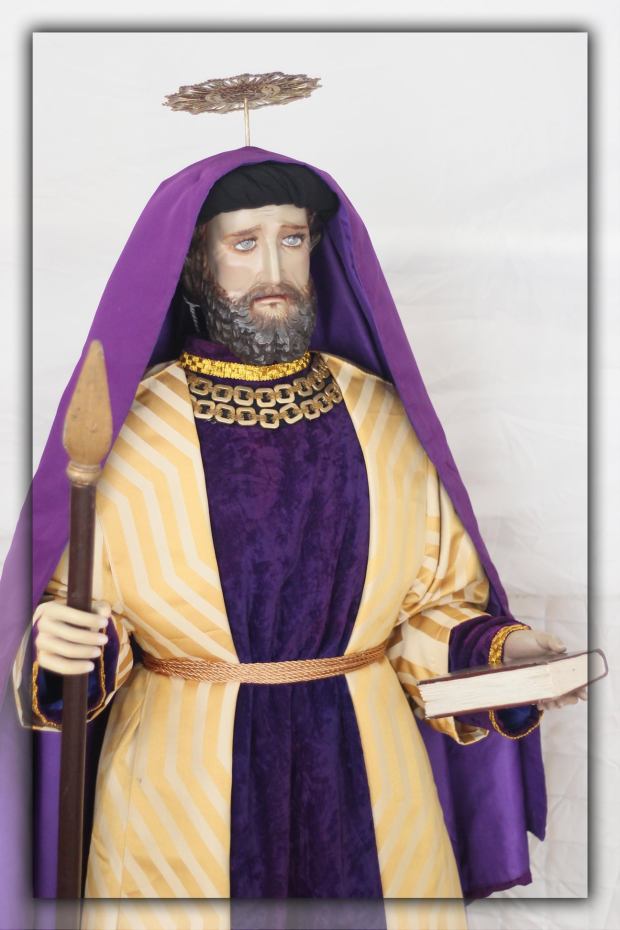
Feast: July 3
Iconography: spear
Saint Thomas, one of the twelve apostles of Christ, gained notoriety for initially doubting the resurrection of Jesus, but later affirmed his belief after touching the wounds on Jesus’ hands and side. It is believed that he preached the Gospel in India, where he was ultimately martyred for his faith by being speared to death. He is recognized as the patron saint of architects.
San Bartolome

Feast: August 24
Iconography: knife, skin
St. Bartholomew, recognized as one of the twelve apostles of Jesus Christ, was thought by some to be Nathanael, whom Christ described as the “True Israelite” due to his candid nature. It is said that he preached in Armenia before being apprehended, flayed alive, and ultimately decapitated. He is venerated as the patron saint of exorcists, tanners, and shoemakers.
San Judas Tadeo
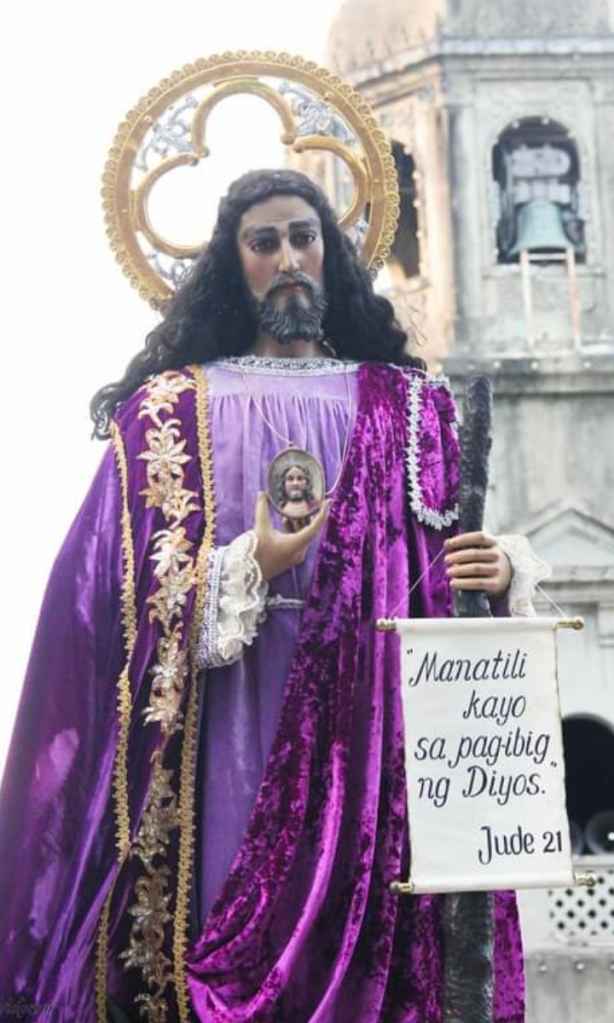
Feast: October 28
Iconography: The Mandylion or a Medal of the Holy Face of Jesus, a club, a scroll
St. Jude, one of the twelve apostles of Jesus and a close relative of Him, is credited with authoring one of the epistles in the New Testament. According to tradition, he preached in Libya and Armenia and possessed the Mandylion of Edessa, which bears the imprint of Jesus’ face. It is believed that Jesus sent St. Jude to the King of Edessa, who was healed after being presented with the cloth. St. Jude’s martyrdom is said to have involved either beheading or being clubbed to death. He is venerated as the patron saint of desperate cases, alongside St. Rita of Cascia.

Feast: October 28
Iconography: Saw
St. Simon, known as the “Zealot,” was among the twelve apostles of Jesus, who was believed to be a member of a political group that aimed to remove the Romans from Palestine. Although the Bible doesn’t mention much about him, tradition states that he was martyred together with St. Jude, and was sawn in half. He is now venerated as the patron saint of lumberjacks.
San Mateo

Feast: September 21
Iconography: a quill, a book or scroll, an angel
St. Matthew, one of the twelve apostles and a Gospel writer, was the son of Alpheus and likely born in Galilee. Despite working as a tax collector, which was a reviled profession during Christ’s time, he was called by Jesus with a simple request to “Follow me.” Matthew became a disciple and chronicled Christ’s deeds and teachings in his gospel. After Christ’s Ascension, between 41 and 50 AD, Matthew penned his account in Aramaic, hoping to persuade his people that Jesus was the Messiah and that His kingdom was fulfilled spiritually, open to all who come to God through Him.
El Oracion en el Huerto

On this occasion, Jesus’ human nature and his divine nature are clearly seen. After the Last Supper, Jesus goes with his apostles to the Garden of Gethsemane, an olive tree plantation. Jesus takes Peter, James, and John further into the garden with him. In the Garden of Gethsemane, Jesus was pressed with the extreme pressure of his suffering for all of us that his blood, oozed from his pores. An angel came from heaven to strengthen him. During his agony as he prayed, “His sweat was, as it were, great drops of blood falling down upon the ground” (Luke 22:44).
El Beso de Judas Iscariote

Late that evening in Gethsemane, Jesus was betrayed with a kiss by Judas Iscariot who addressed him as “rabbi” to reveal his identity in the darkness to the crowd who had come to arrest him. Judas betrayed Our Lord for thirty pieces of silver which is a proverb in many modern languages. It refers to someone who has sold out and taken money, high office, or personal gain in exchange for betraying a person or an important cause. According to the Gospel of Matthew, Judas immediately regretted his actions and returned the 30 pieces of silver to church authorities, and committed suicide. In this paso, Judas is portrayed kissing Our Lord holding a bag of thirty pieces of silver alluding to his betrayal.
Ang Pagdakip kay Hesus
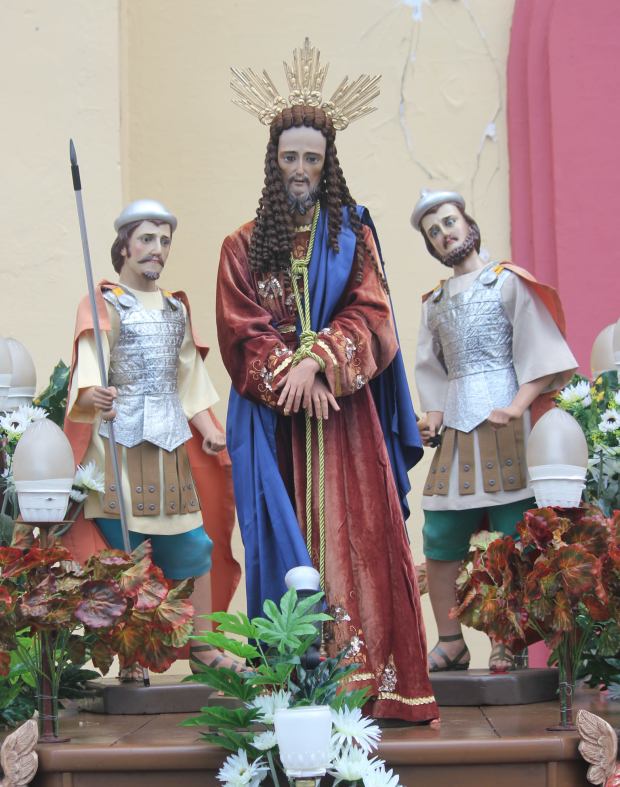
Jesus was arrested by the Temple guards of the Sanhedrin in the Garden of Gethsemane. The arrest led immediately to his trial before the Sanhedrin, during which they condemned him to death and handed him to Pilate the following morning. The Gospel of John specifies that was Peter wounded an officer servant of Caiaphas, the High Priest of Israel. St. Luke adds in his account that Jesus healed the wound. Jesus criticized the violent act of Peter that made the well-known statement “All who live by the sword, shall die by the sword”
Si Hesus sa harapan ni Annas

Although Caiaphas was the properly appointed high priest, Annas, being his father-in-law and a former incumbent of the office, undoubtedly exercised a great deal of the power attached to the position. According to the Gospel of John, Jesus was first brought before Annas, and after a brief questioning of him (John 18:19–23) was sent to the home of Caiaphas, where some members of the Sanhedrin had met, and where in Matthew’s account the first trial of Jesus took place.
Si Hesus sa harapan ni Caiphas at ng Sanhedrin

From Annas, Jesus was sent to the house of Caiaphas, the high priest, and the Sanhedrin broke Jewish customs to hold a hearing and decide Jesus’s fate. They said, “If you are the Messiah, tell us,” but he replied to them, “If I tell you, you will not believe, and if I question, you will not respond. But from this time on the Son of Man will be seated at the right hand of the power of God.” They all asked, “Are you then the Son of God?” He replied to them, “You say that I am.” Then they said, “What further need have we for testimony? We have heard it from his own mouth.” They charged Jesus with blasphemy and were later sent to Herod.
Ang Pagtatuwa ni San Pedro kay Hesus

Now Peter was sitting outside in the courtyard. One of the maids came over to him and said, “You too were with Jesus the Galilean.” But he denied it in front of everyone, saying, “I do not know what you are talking about!” As he went out to the gate, another girl saw him and said to those who were there, “This man was with Jesus the Nazorean.” Again he denied it with an oath, “I do not know the man!” A little later the bystanders came over and said to Peter, “Surely you too are one of them; even your speech gives you away.” At that, he began to curse and swear, “I do not know the man.” And immediately a cock crowed. Then Peter remembered the word that Jesus had spoken: “Before the cock crows you will deny me three times.” He went out and began to weep bitterly. (Matthew 26: 69-75)
Si Hesus sa harapan ni Pilato

The chief priests with the elders and the scribes, that is, the whole Sanhedrin, held a council. They bound Jesus, led him away, and handed him over to Pilate. Pilate questioned him, “Are you the king of the Jews?” He said to him in reply, “You say so.” The chief priests accused him of many things. Again Pilate questioned him, “Have you no answer? See how many things they accuse you of.” Jesus gave him no further answer so Pilate was amazed. (Mark 15: 1-5) Pilate sent Jesus to Herod Antipas because he was a Galilean.
Si Hesus sa harapan ni Herodes

When Herod saw Jesus, he was very glad, for he had long desired to see him because he had heard about him, and he was hoping to see some sign done by him. 9 So he questioned him at some length, but he made no answer. 10 The chief priests and the scribes stood by, vehemently accusing him. 11 And Herod with his soldiers treated him with contempt and mocked him. Then, arraying him in splendid clothing, he sent him back to Pilate. 12 And Herod and Pilate became friends with each other that very day, for before this they 0had been at enmity with each other. (Luke 23: 8 – 12)
Ang Ikalawang Pagharap ni Hesus kay Pilato

Pilate who then calls together the Court elders, and says to them: “I having examined him before you, found no fault in this man touching those things whereof ye accuse him: no, nor yet Herod: for he sent him back unto us; and behold, nothing worthy of death hath been done by him.” Pilate’s wife Claudia Procula begged him to release Jesus after a dream. He later present Jesus and Barabbas and asked whom should he release. The Chief priests and elders persuaded the crowd against Jesus. Pilate asked the crowd and they shouted Barabbas as the one to be released and Jesus to be crucified. Pilate washed his hands of guilt and said: ‘I’m innocent of this man’s blood, it’s your responsibility!’ The crowd responded: “His blood is on us and on our children!” Pilate released Barabbas and had Jesus scourged.
Ang paghahampas sa haliging bato
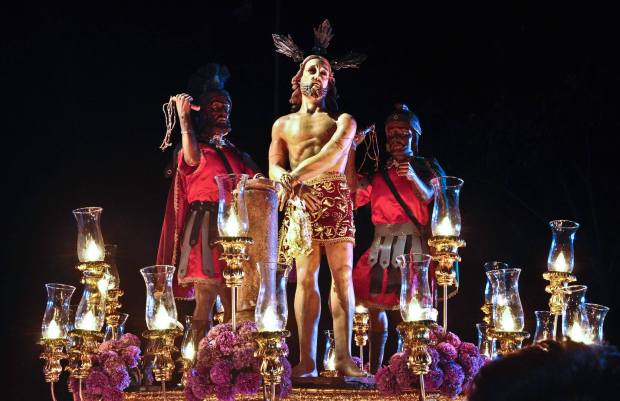
It is fairly clear that Pontius Pilate tried to save Jesus by offering the crowd an unattractive alternative, Barabbas. As we know, this ploy failed. He had Jesus savagely flogged and then paraded before the crowd in an attempt to gain pity. It was clear to him, and he reasoned it should be clear to the crowd, that this pitiable object before them could not be taken seriously as a king. Scourging was a brutal punishment, but it was standard practice before a crucifixion. The whip, the flagellum, had several thongs, each one of which had pieces of bone or metal attached. It made a bloody pulp of a man’s body.
Señor Desmayado

The image of the Señor Desmayado (the Fainting Lord in Spanish) depicts Our Lord Jesus Christ of Christ sprawled and tied to a column exhausted, writhing on the floor, his left arm tied to a pillar by the wrist, his body bloodied and covered with welts. Christ’s s eyes are drawn up in supplication, his mouth agape, grimacing from his indescribable torture.

Often times the Señor Desmayado is shown as a solitary image or accompanied by soldiers to mock him or angels to console him.
Ang pagpuputong ng Koronang tinik
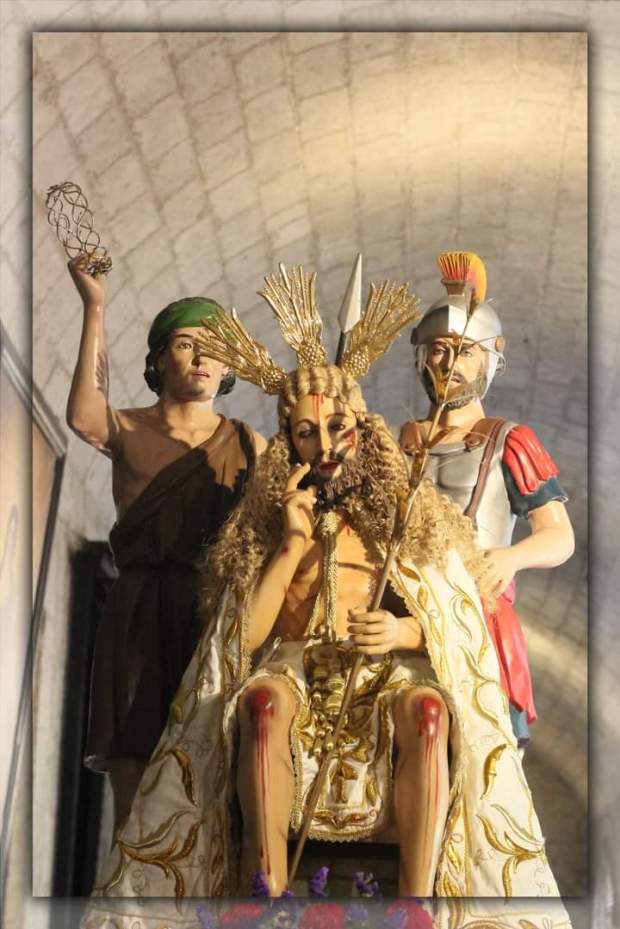
After the soldiers had flogged Jesus, they engaged in some brutal horseplay with their helpless prisoner. They set about playing out a grotesque charade in which Jesus was a royal king – of sorts. They wove spiky twigs into a rough crown of thorns and set it on his head. The ‘crown of thorns may have been meant more as mockery than torture. Once they had crowned their ‘king’ they draped a scarlet cloak around his shoulders. And they spat upon him, and took the reed and struck him on the head. No doubt there was a great deal of cruel laughter at the expense of their victim, as they hit him with reed canes, mocking his helplessness. And when they had mocked him, they stripped him of the robe, and put his own clothes on him, and led him away to crucify him.
Ang Paghuhula at Paglilibak kay Hesus
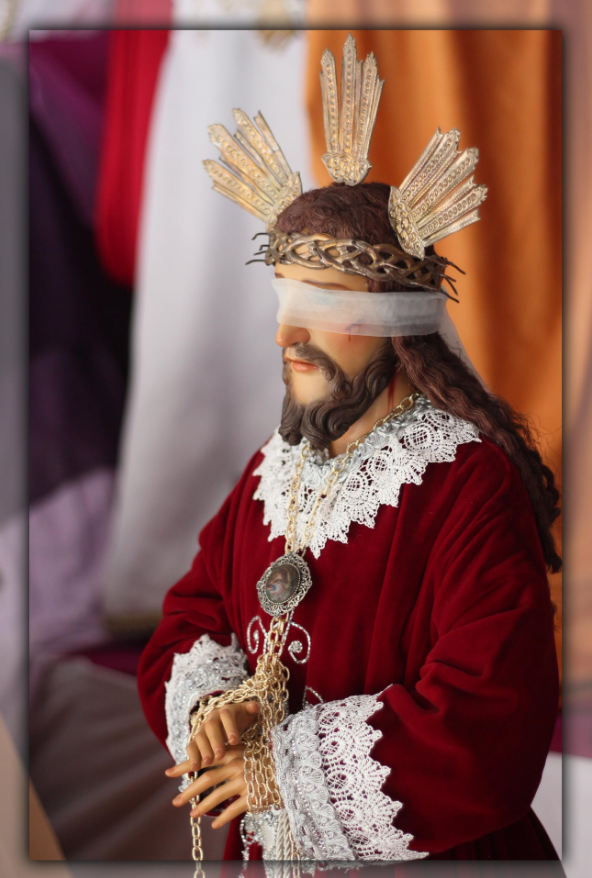
The men who were guarding Jesus began mocking and beating him. They blindfolded him and demanded, “Prophecy! Who hit you?” And they said many other insulting things to him. (Luke 22:63-65)
Señor de la Paciencia

One of the most moving images processioned during the Lenten season is the image of a seated Christ, right after he was scourged, crowned, cloaked, and mocked. On a low stone seat, an exhausted Jesus sits bound with his hands on his chin, in deep contemplation of his inevitable fate that is forthcoming and crowned with thorns, wearing a loin cloth, a rope yoke, and a red or purple cloak and holding a reed scepter as a symbol of mockery. Spanish and Latin American countries have a longer appellation for this seated Christ as El Cristo de la Humildad y Paciencia (Christ of Humility and Patience).
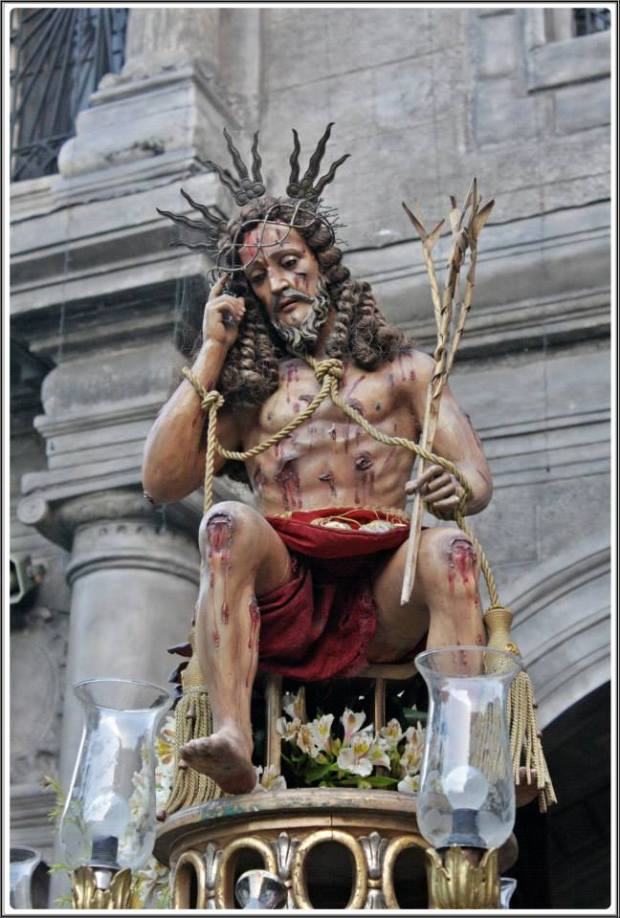
Some images of La Paciencia were often a solitary image or with soldiers. The devotion of Señor de la Paciencia gained popularity, especially in Intramuros, Manila during the Spanish era, unfortunately, the image was destroyed during the Second World War.
Nuestro Padre Jesus de la Sentencia

After Jesus was scourged, crowned with thorns, and mocked, he was once again presented to Pontius Pilate. Pilate, outside, repeated his not guilty verdict and presented Jesus to the crowd: “Ecce Homo!” (Behold the Man!). The scene has been widely depicted in Christian art. A scene of the Ecce Homo is a standard component of cycles illustrating the Passion and Life of Christ in art. From the 15th century in the West, and much earlier in the art of the Eastern church, devotional pictures began to portray Jesus alone, in half or full figure with a purple robe, loincloth, crown of thorns, and torture wounds, especially on his head, and later became referred to as images of the “Ecce Homo”.
Ang Paghahatol kay Hesus
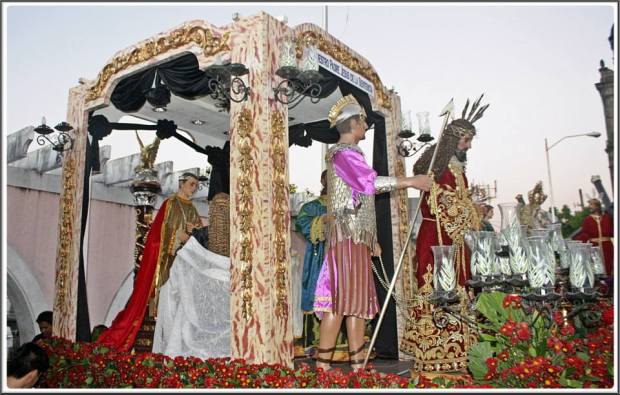
As Pilate presents Jesus to the crowd, the Chief priests and officials shouted: ‘Crucify him! Crucify him!’ He wanted to set Jesus free yet the Jewish leaders and priests shouted: “We have no king but Caesar”. Pilate handed Jesus over to them for to be crucified.
Ang Pagtanggap sa Krus

So they took Jesus, and carrying the cross himself he went out to what is called the Place of the Skull, in Hebrew, Golgotha. A heavy cross is laid upon the bruised shoulders of Jesus. He receives it with meekness and with a sense of commitment, for it is the instrument with which he is to redeem the world and to accomplish the mission for which his heavenly Father has sent him.
Nuestro Padre Hesus Nazareno

Jesus said to his disciples, “Whoever wants to be my disciple must deny themselves and take up their cross and follow me”. (Matthew 16:24) In Spain and its former colonial realm, the title of Nuestro Padre Jesus Nazareno is associated with the image of Our Lord Jesus Christ carrying the Cross on His way to Mount Calvary.
The image of the Nazareno is often featured in the Via Crucis Processions and Estacion General Processions throughout Lent and Holy Week. The devotion to the Nazareno became popular in the country with Quiapo, Manila as the center of the devotion.
Ang unang pagkadapa ni Hesus
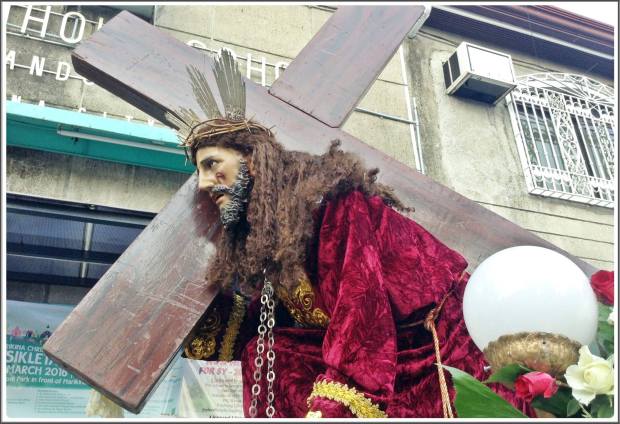
Bowed down under the weight of the cross, Jesus slowly sets forth on the way to Calvary, amidst the mockeries and insults of the crowd. His agony in the garden has exhausted his body. He is lacerated with blows and wounds; his strength fails Him. He falls to the ground under his cross.
La Amargura
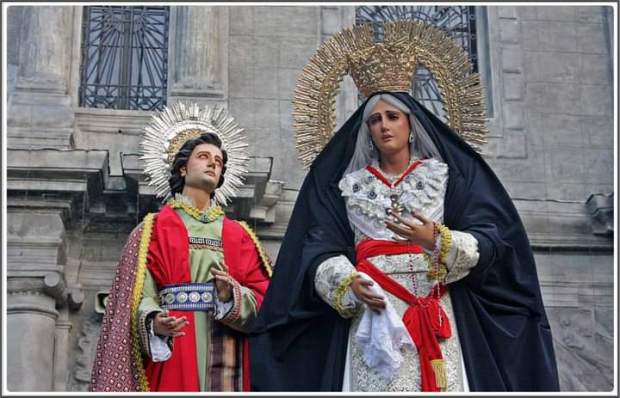
Although La Amargura (the Virgin of Bitterness) was not recorded in the Four Canonical Gospels, the scene where St. John the Evangelist accompanying the Blessed Virgin Mary to her Son on the Way of the Cross was written in numerous writings from mystics. In one of the mystical writings, specifically in the writings of Blessed Anne Catherine Emmerich, St. John the Evangelist accompanied the Blessed Mother in walking to many of the spots sanctified by our Lord with his blood and watering them with her tears along the way.
The Paso and devotion to Maria Santisima de la Amargura take its roots in Seville, Spain as it is one of the most popular in the Semana Santa procession in the Andalusian region.
Ang Pagtatagpo ni Hesus at ng kanyang Ina

Blessed Anne Catherine Emmerich recorded the following: “As she was about to reach her Son on the Via Dolorosa, the soldiers taunt her with the instruments of the Passion, she could not control her feelings, but joined her hands as if to implore the help of heaven. When she saw her Son, she fixed her eyes upon Jesus, who was drawing near, and leaned against the pillar for support, lest she should again faint from grief, for her cheeks were as pale as death, and her lips almost blue. Then came her beloved Son. He was almost sinking under the heavyweight of his cross. and his head, still crowned with thorns, was drooping in agony on his shoulder. He cast a look of compassion and sorrow upon his Mother, staggered, and fell for the second time upon his hands and knees. Mary has perfectly agonized at this sight; she forgot all else; she saw neither soldiers nor executioners; she saw nothing but her dearly loved Son; and, springing from the doorway into the midst of the group who were insulting and abusing him, she threw herself on her knees by his side and embraced him. A few of the soldiers looked touched; and, although they obliged the Blessed Virgin to retire to the doorway, not one laid hands upon her. John and the women surrounded her as she fell half fainting against a stone, which was near the doorway, and upon which the impression of her hands remained.”
Ang pagtulong ni Simeon Cireneo

They (the soldiers) pressed into service a passer-by, Simon, a Cyrenian, who was coming in from the country, the father of Alexander and Rufus, to carry his cross. (Mark 15: 21)
Ang pagpahid sa mukha ni Hesus ni Santa Veronica

As Jesus proceeds along the way covered with the sweat of blood, a woman, moved with compassion, makes her way through the crowd, and wipes his face with a handkerchief. As a reward for her piety, the impression of His sacred countenance is miraculously imprinted upon the handkerchief.
Santa Veronica

Feast: July 12
Iconography: The Veil with the imprint of the Holy Face of Jesus
According to tradition, St. Veronica is known as the woman who wiped the face of Jesus as he was on his way to Mount Calvary. In the “Pasyong Mahal,” it is said that when she folded her veil, the image of Jesus’ face appeared on it. Some mystics, including Blessed Catherine Emmerich, believe that St. Veronica is also the woman who was healed of internal bleeding when she touched the hem of Jesus’ clothes. Another tradition states that St. Veronica presented the veil to the Blessed Mother and other women disciples. On Passion Sunday (Fifth Sunday of Lent), the Veil of Veronica is briefly exposed to bless the people on the altar dedicated to her. She is venerated as the Patroness of Photographers and caretakers of Sacred images.
Ang ikalawang pagkadapa ni Hesus

The pain of his wounds; and the loss of blood increasing at every step of his way, weakens him; and Jesus falls to the ground for the second time.
Nakasalubong ni Hesus ang mga kababaihan ng Jerusalem

A large crowd of people followed Jesus, including many women who mourned and lamented him. Jesus turned to them and said, “Daughters of Jerusalem, do not weep for me; weep instead for yourselves and for your children, for indeed, the days are coming when people will say, ‘Blessed are the barren, the wombs that never bore and the breasts that never nursed.’ At that time, people will say to the mountains, ‘Fall upon us!’ and to the hills, ‘Cover us!’ for if these things are done when the wood is green what will happen when it is dry?” (Luke 23: 27-31)
Ang Ikatlong pagkadapa ni Hesus

Jesus has almost arrived at the summit of Calvary, but before he reaches the spot where he is to be crucified, his strength again fails Him, and he falls the third time.
El Señor Jesus Despojado

Jesus, at last, arrives at Golgotha and they prepare to crucify Him. They strip Him of His garments and mock Him. Clothing gives a man his social position; His public stripping means that Jesus is no longer anything at all, he is simply an outcast, despised by all alike. The moment of the stripping reminds us of the expulsion from Paradise: God’s splendor has fallen away from man, who now stands naked and exposed, unclad and ashamed. And so Jesus once more takes on the condition of fallen man. At the foot of the Cross, the soldiers draw lots to divide his paltry possessions, his clothes in fulfillment of the words of the Psalms. He was then offered a wine mixed with myrrh to drink, but he refused to drink it choosing to endure with full consciousness the sufferings appointed for Him.
Nuestro Padre Señor de las Penas

The image of Nuestro Padre Jesus de las Penas, shows Jesus stripped of his garments, about to be crucified, once again praying for strength and patience to complete his mission to die for the salvation of many.
Ang pagapako sa Krus

When they came to the place called the Skull, they crucified him and the criminals there, one on his right, the other on his left. Then Jesus said, “Father, forgive them, they know not what they do.” (Luke 23: 33-34) Stake-like nails were driven through his wrists and ankles, fastening him to the cross. The inscription above his head tauntingly read, “The King of the Jews.”
Ang pagpapatawad sa mabuting magnanakaw

Now one of the criminals hanging there reviled Jesus, saying, “Are you not the Messiah? Save yourself and us.” The other, however, rebuking him, said in reply, “Have you no fear of God, for you are subject to the same condemnation? And indeed, we have been condemned justly, for the sentence we received corresponds to our crimes, but this man has done nothing criminal.” Then he said, “Jesus, remember me when you come into your kingdom.” He replied to him, “Amen, I say to you, today you will be with me in Paradise.” (Luke 23: 39-43)
San Dimas
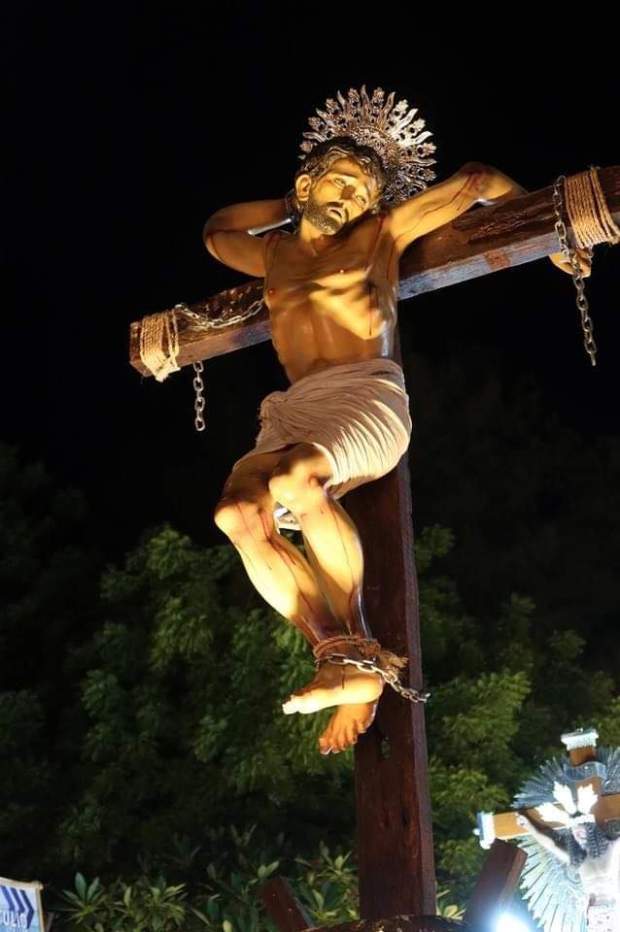
Feast: March 25
Iconography: A large Cross, shirtless
St. Dismas is known as the repentant thief who was crucified alongside Jesus, and who was promised Divine Mercy and taken to Paradise by Christ after repenting. Depictions of him often show a large cross, referencing his own crucifixion, and he is sometimes portrayed shirtless due to his appearance during the crucifixion.
In the Coptic Church, it is said that he had previously encountered the Holy Family on their journey to Egypt, as he was the leader of a group of thieves who attempted to rob them but ultimately had a change of heart. A reported apparition of St. Dismas to St. Porphyrios describes how he was instructed by Jesus to come down from the cross and save a sick man lying nearby, which he did with the help of pieces of Christ’s cross. St. Dismas is revered as the patron saint of repentant criminals.
Ang paghahabilin ni Hesus
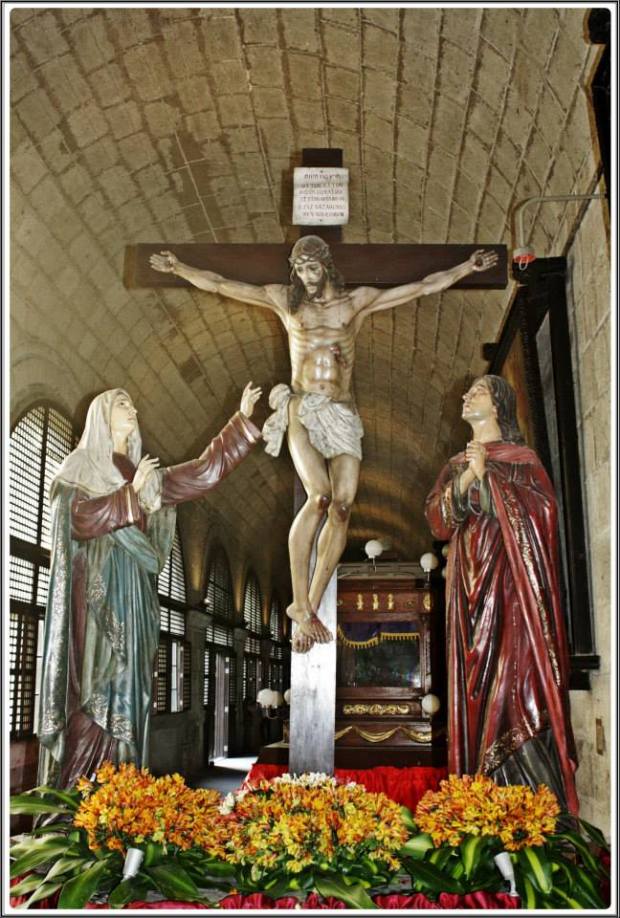
Standing by the cross of Jesus were his mother and his mother’s sister, Mary the wife of Cleophas, and Mary of Magdala. When Jesus saw his mother and the disciple there whom he loved, he said to his mother, “Woman, behold, your son.” Then he said to the disciple (St. John the Evangelist), “Behold, your mother.” And from that hour the disciple took her into his home. (John 19: 25-27)
Ang pagpapainom kay Hesus
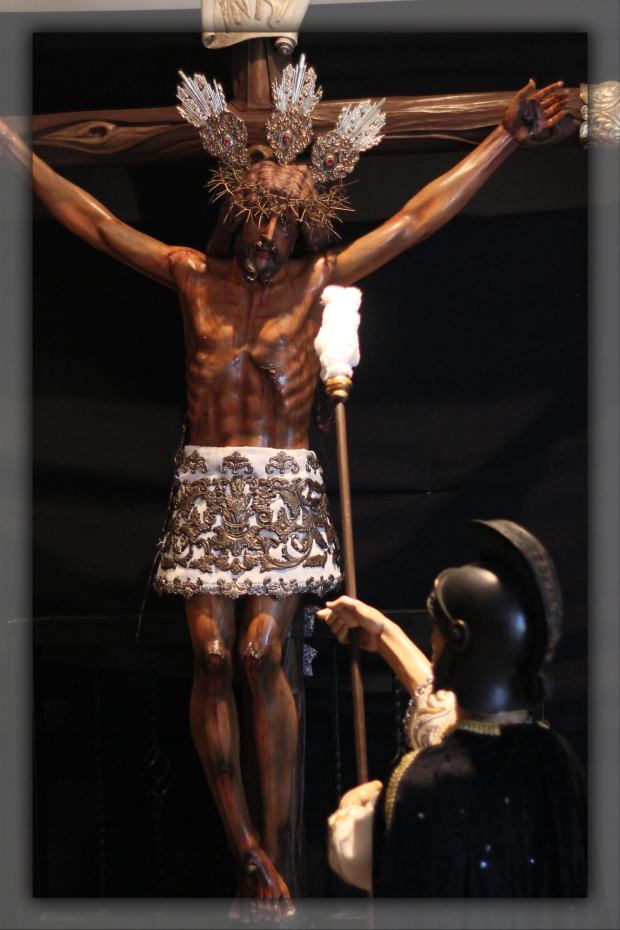
“After this, Jesus, knowing that all was now finished, said (to fulfill the Scripture), ‘I thirst.’ A jar full of sour wine stood there, so they put a sponge full of the sour wine on a hyssop branch and held it to his mouth.” (John 19:28-29) Jesus did drink, but what many people believe to be vinegar was nothing of the sort. The Romans did not give him vinegar. They gave him sour wine. Sour wine was there to quench the thirst of the soldiers. The cheap beverage was refreshing to keep him onscious for as long as possible,” and thus have the effect of prolonging his pain that would accomplish God’s purpose.
Ang pagkamatay sa Krus ni Hesus
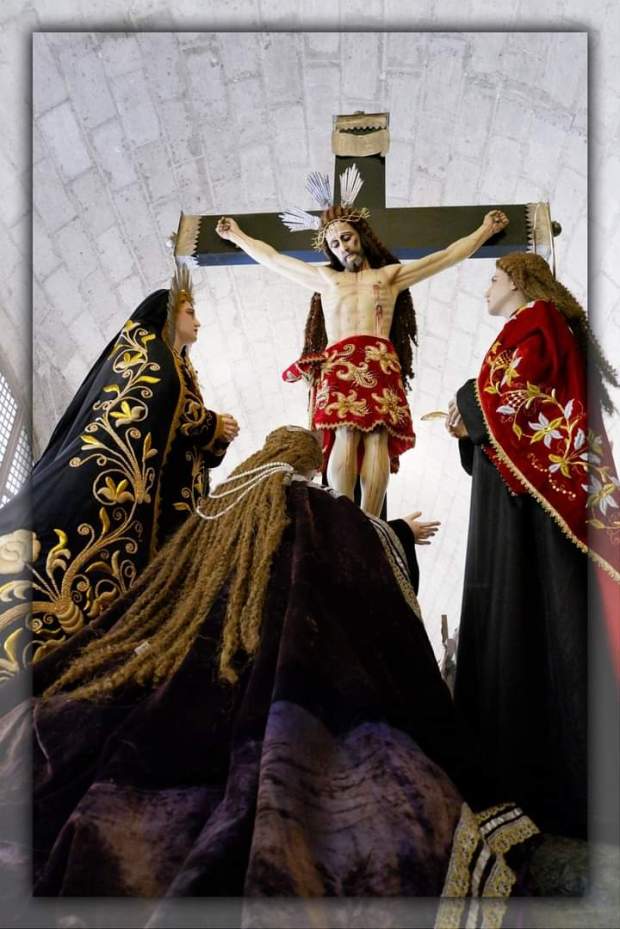
It was now about noon and darkness came over the whole land until three in the afternoon because of an eclipse of the sun. Then the veil of the temple was torn down the middle. Jesus cried out in a loud voice, “Father, into your hands I commend my spirit”; and when he had said this he breathed his last. (Luke 23: 44-46). As soon as Our Lord Jesus died, an earthquake shook the ground and the rocks split, ripping the Temple veil in two from top to bottom. The tombs broke open and the bodies of many holy people who had died were raised to life.
Ang Pagsibat ni San Longinos kay Hesus sa Krus
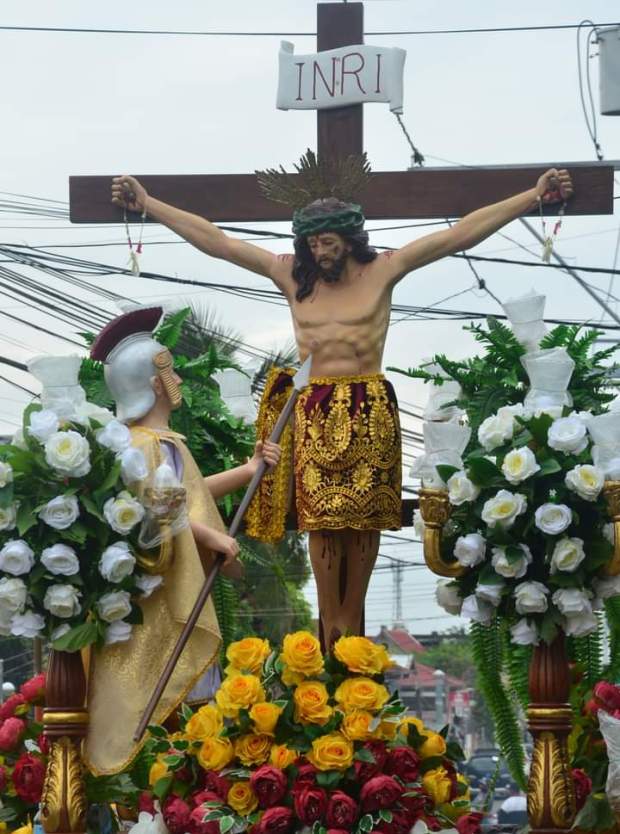
Since it was the Day of Preparation, to prevent bodies from remaining on the cross on the Sabbath day (for that Sabbath day was a high day), the Jews asked Pilate that their legs might be broken and that they might be taken away. Therefore the soldiers came and broke the legs of the first and of the other who was crucified with Him. But when they came to Jesus and saw that He was dead already, they did not break His legs. However, one of the soldiers pierced His side with a spear, and immediately blood and water came out. He who saw it has testified, and his testimony is true. He knows that he is telling the truth, that you may believe. For these things happened so that the Scripture should be fulfilled, “Not one of His bones shall be broken,”[a] and again another Scripture says, “They shall look on Him whom they have pierced. (John 19:31-37)
The soldier who pierced the side of Our Lord Jesus Christ is identified by tradition as St. Longinus. His spear is venerated in Rome which is briefly exposed for veneration on the Fourth Sunday of Lent
San Longinos

Feast: October 16 (Present Liturgical Calendar), March 15 (Traditional Calendar)
Iconography: spear
According to tradition, St. Longinus was the centurion who pierced the side of Jesus and was healed of his eye disease when blood and water flowed from the wound. He then proclaimed that Jesus is the Son of God, converted to Christianity, and was later martyred in Cappadocia. His story is depicted in the first known Pasyon by Padre Gaspar Aquino de Belen and in the Moriones Festival in Marinduque.
A statue of St. Longinus can be found at St. Peter’s Basilica. St. Longinus is considered the patron saint of those with eye problems and good discernment.
Ang pababa sa Krus
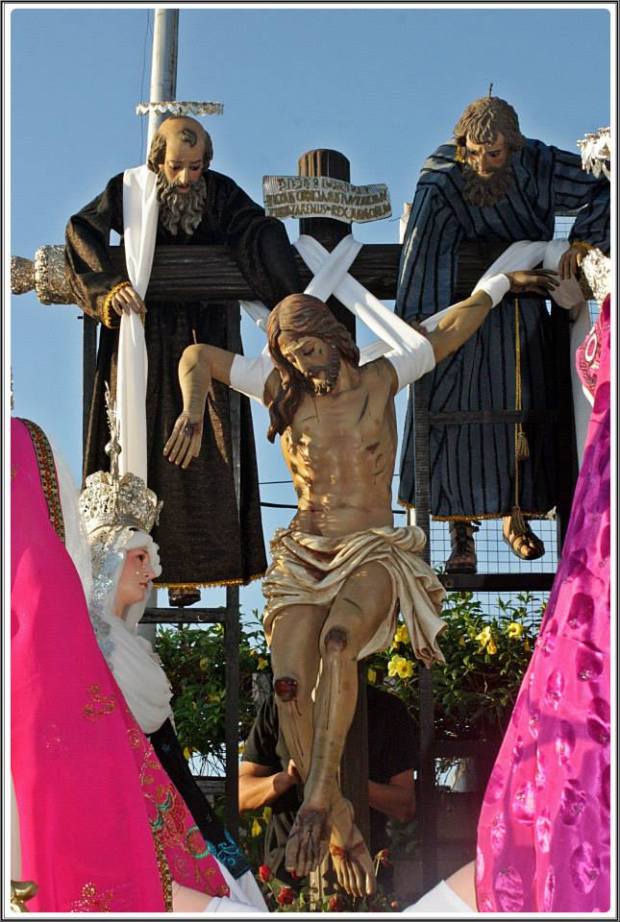
After these things, Joseph of Arimathea, who was a disciple of Jesus, though a secret one because of his fear of the Jews, asked Pilate to let him take away the body of Jesus. Pilate gave him permission; so he came and removed his body. (John 19:38)
La Piedad

When the body of Our Lord Jesus Christ was taken down from the Cross, Joseph of Arimathea and Nicodemus take down the body of Jesus from the cross and place him in the arms of his afflicted mother.
Ang Paglilibing kay Hesus

When it was evening, there came a rich man from Arimathea named Joseph, who was himself a disciple of Jesus. He went to Pilate and asked for the body of Jesus; then Pilate ordered it to be handed over. Nicodemus, who at first came to Jesus by night, also came, bringing a mixture of myrrh and aloes, weighing about seventy-five pounds. Taking the body, Joseph wrapped it [in] clean linen and laid it in the new tomb that he had hewn in the rock. Then he rolled a huge stone across the entrance to the tomb and departed. (Matthew 27: 57-60, John 19:39)
San Nicodemo

Feast: August 31
Iconography: a jar
St. Nicodemus, a Sanhedrin member who became a disciple of Jesus Christ, engaged in one of the most profound theological conversations in the Gospels with our Lord. One night, he approached Jesus seeking guidance on how to attain salvation, to which Jesus replied that one must be reborn from above, referring to baptism. After Jesus’ death, Nicodemus assisted St. Joseph of Arimathea in burying him, and he brought a mixture of myrrh and aloes for Jesus’ body, which is why he is often depicted holding a jar in his iconography.
San Jose de Arimatea
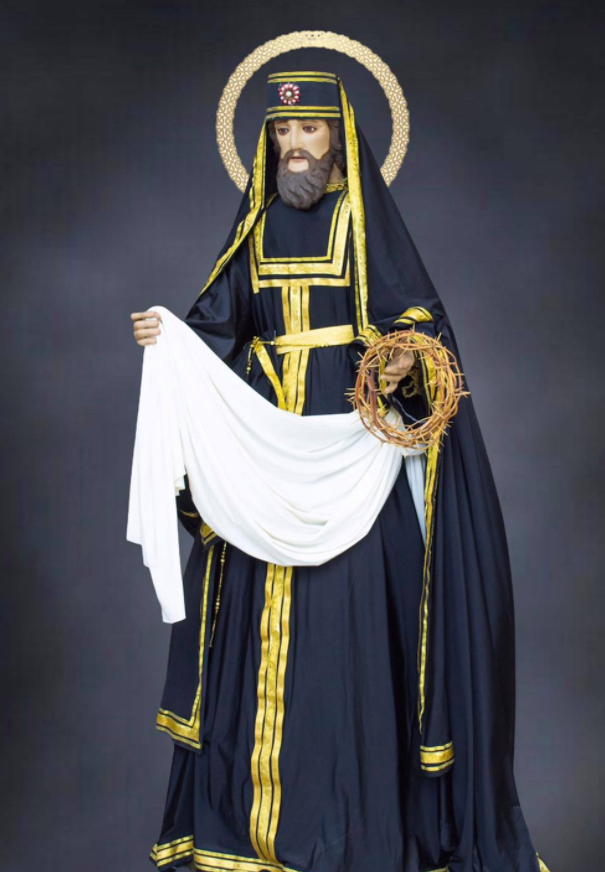
Feast: August 31
Iconography: Crown of thorns, linen cloth, a scroll, chalice
St. Joseph of Arimathea, a covert disciple of our Lord Jesus Christ, was a member of the Sanhedrin. Following Jesus’ death, he sought permission from Pontius Pilate to take the Lord’s body for burial and brought a linen shroud. Together with St. Nicodemus, he prepared Christ’s remains for burial. According to tradition, he also kept the Holy Grail and owned the grave where Jesus was buried. He is venerated as the patron saint of funeral directors.
San Cleofas

Feast: September 25
Iconography: Bread
According to tradition, St. Cleophas was a disciple of Jesus who may have been the brother of St. Joseph, the foster father of Christ. Some sources suggest that he may be the same person as Alpheus. It is said that his wife was St. Mary of Cleophas, who witnessed the crucifixion and resurrection of Jesus. In the Gospel of Luke, he is depicted traveling to Emmaus with another unnamed disciple. They encounter Jesus, but do not recognize him until he breaks bread with them during dinner, hence the symbol of bread associated with St. Cleophas.
San Matias

Feast: May 14
Iconography: axe, book
St. Matthias was a disciple of Jesus and was selected to take the place of Judas Iscariot as an apostle. He had been a follower of Christ since His baptism in the Jordan River, but the Bible does not offer any further information about him after his appointment. According to tradition, he preached in present-day Georgia and was eventually martyred by being dismembered. St. Matthias is venerated as the patron saint of those struggling with alcoholism.
San Jose Barsabbas Justo
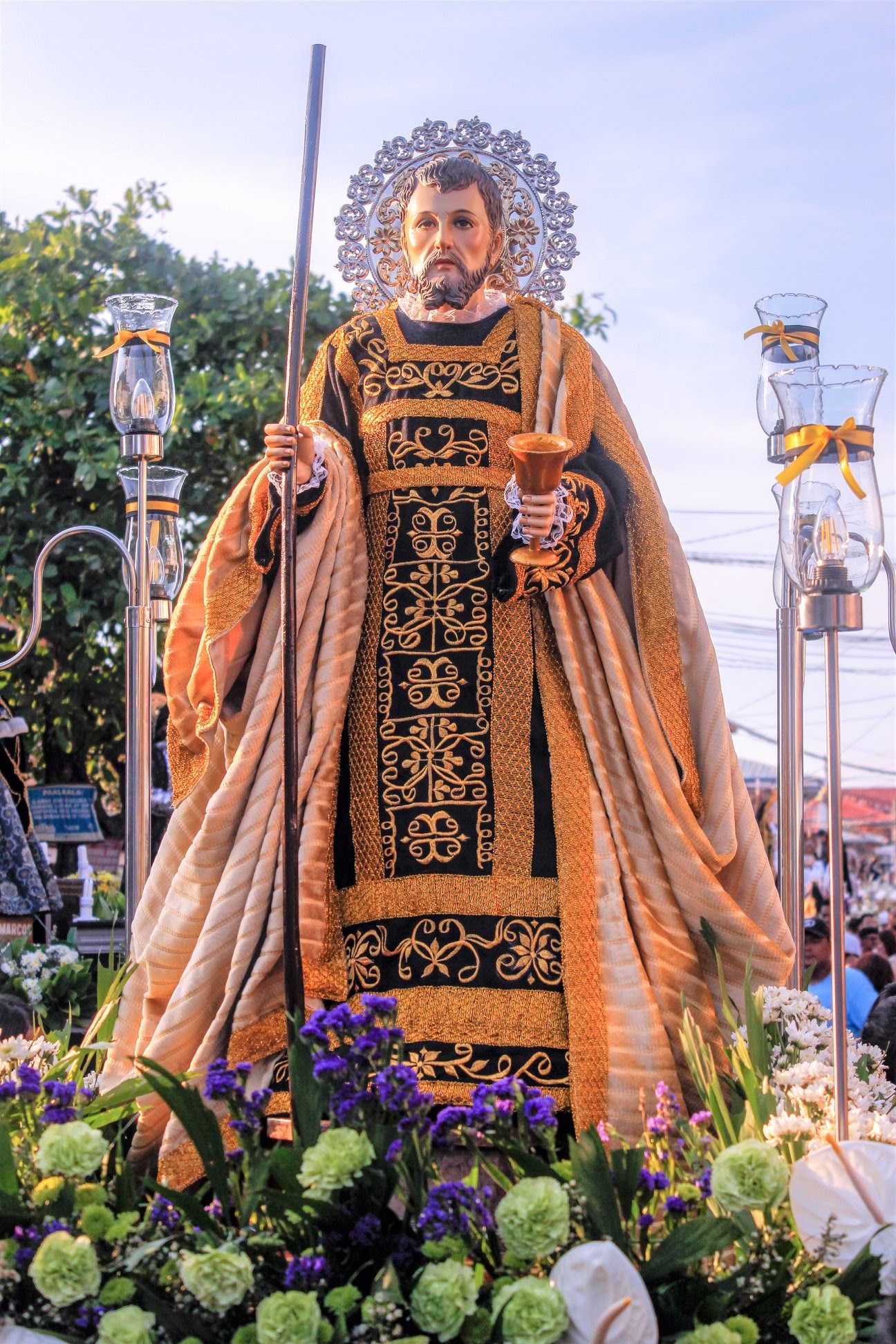
Feast: July 20
Iconography: Cup
Saint Joseph Barsabbas, also known as Justus, was a follower of Jesus who was considered as one of the two potential successors to Judas by the apostles. Although the lot fell on the other candidate, St. Matthias, Joseph Barsabbas still actively participated in the ministry of preaching and holiness. According to tradition, he became the bishop of Eleutheropolis, where he was eventually martyred. It is said that he survived an attempt to poison him, which is why his iconography often depicts him holding a cup.
San Simeon de Jerusalem

Feast: September 25
Iconography: crosier and a cross
St. Simeon of Jerusalem is believed to be the offspring of St. Cleophas, also known as Alpheus, who was the brother of St. Joseph, and Mary, the sister of the Blessed Virgin Mary. As a result, he was both a nephew of St. Joseph and the Blessed Virgin Mary and a cousin of Our Savior. He may also have been the unnamed disciple who encountered Jesus in Emmaus. According to tradition, St. Simeon was the second bishop of Jerusalem and was crucified during the persecution of Trajan.
Santa Marta de Betania

Feast: July 29
Iconography: Basket of fruits or food
St. Martha was the sister of St. Lazarus and St. Mary of Bethany, and their home was a frequent place for Jesus to teach and dine. She was often busy in the kitchen preparing food for Christ. When her brother, St. Lazarus, died, she professed her faith in Jesus and believed in the resurrection of the dead. Some Eastern Churches believe that she was among the women who witnessed Jesus’ death and resurrection. Tradition holds that she and other disciples were exiled to France, where she preached the Gospel in Tarascon and tamed the terrifying tarasque. She is widely venerated as the patron saint of waiters and is also the patron saint of the Municipality of Pateros in Metro Manila.
Santa Maria de Betania

Feast: July 29
Iconography: Perfume bottle and holding her hair
St. Mary, the sister of St. Martha and St. Lazarus, was a dear friend of Jesus. During one of Jesus’ teachings in their home, she sat next to him and listened attentively, while her sister complained about her not helping in the kitchen. Jesus reprimanded Martha and praised Mary, saying, “There is need of only one thing. Mary has chosen the better part, and it will not be taken away from her.” She is also known as the woman who anointed Jesus’ feet with expensive perfume and dried them with her hair. In 2021, Pope Francis established the Feast of the Bethany Siblings (St. Martha, St. Mary, and St. Lazarus) to be celebrated every July 29th.
Santa Maria Cleofe

Feast: April 24
Iconography: censer
St. Mary of Cleophas is frequently associated with St. Cleophas, who traveled to Emmaus with Jesus. According to St. John’s Gospel, she is referred to as the “sister” (adelphi) or sometimes considered as the sister-in-law of the Blessed Virgin Mary. She served Jesus and was present at the Crucifixion, and later accompanied Mary Magdalen to Christ’s tomb. Additionally, the Gospel of St. Mark notes that Mary of Cleophas was among the women from Galilee who frequently accompanied Jesus during his ministry and assisted him in his work.
In traditional iconography, the attribute of Santa Maria Jacobe or Cleofe is an alabaster jar yet the two either carry a censer for Franciscan and Dominican territories while a broom for Augustinian parishes.
Santa Maria Jacobe

Feast: May 23
Iconography: broom or Roman whip
St. Mary of James, also known as the wife of Alpheus and mother of St. James the Younger and St. Jude Thaddeus, was given the title “Mary of James” because, according to Hebrew custom, a widowed woman is placed under the authority and responsibility of her eldest son, in this case, St. James the Younger. She was present at Calvary during Jesus’ crucifixion and was among the women disciples who witnessed the resurrection of Christ on Easter morning. Some believe that she is depicted holding a Roman flagellum, which is often mistaken for a broom in some images.

In traditional iconography, the attribute of Santa Maria Jacobe or Cleofe is an alabaster jar yet the two either carry a broom for Franciscan and Dominican territories while a censer for Augustinian parishes.
Notes on the identity of Santa Maria Cleofe and Santa Maria Jacobe
For centuries, scholars have debated whether Santa Maria Cleofe and Santa Maria Jacobe are one or two distinct persons from each other. In the recent revisions to the Roman Martyrology of 2001, the Church noted that in the entry of April 24, it described St. Mary of Cleophas as among the women who went to the tomb with St. Mary Magdalene and St. Salome using the Gospel of Mark as the basis. While it may be argued that the updated Martyrology did not explicitly say that the two Marys are the same, it implies that they are when St. Mark’s Gospel was used to describe St. Mary of Cleophas.
Scholars opined that it is quite possible that the two seemingly different Marys were one and the same. Mark distinguished her from other Marys by naming her son; John, by naming her husband. However, Alpheus must be taken to be the same person as Cleopahas for James the Less was the son of Alpheus and Mary; and this Mary was the wife of Cleophas. St. Jerome would identify Alpheus with Cleophas who according to Hegesippus, was the brother of St. Joseph. On the other hand, the proponents of the two Marys as separate entities who object to the identification of Alpheus and Cleophas as one person citing St. Luke’s who speaks about the two male personas separately. In the old Martyrology, there are separate entries for St. Mary of Cleophas (April 9) and St. Mary of James (May 25 together with Sta. Maria Salome in Veroli, Italy) yet it must be pointed out that in the 2001 Martyrology, the entry of St. Mary of James was removed while the entry of St. Mary of Cleophas was transferred to April 24 together with Salome.
As of this writing, while some parishes continued the long-standing tradition of having images of St. Maria Cleofe and St. Maria Jacobe separate, a response was sent from an inquiry from St. John the Baptist Parish in Taytay, Rizal in 2012 regarding this matter from the CBCP Episcopal Commission on the Liturgy. Answering the query on the identity of Santa Maria Cleofe and Santa Maria Jacobe, the response stated that they maintain the stance that the two Marys are the same person until a formal clarification from the Dicastery for the Causes of Saints will be issued to resolve this inquiry.
Whatever would be the truth of the matter, this Mary was prepared for the apostolate of Christ and who deemed it a great blessing and honor to be able to offer her life to God.
Santa Maria Salome

Feasts: April 24 (Present Calendar), October 22 (Traditional Calendar)
Iconography: Broom (Augustinian Parishes), thurible (Franciscan Parishes)
St. Maria Salome, also known as Saint Salome, was among the female disciples of Jesus and the mother of Saint James the Great and Saint John. On one occasion, she requested that her sons be allowed to sit beside Jesus when he establishes his kingdom. She was present during the crucifixion of Jesus Christ, as well as his burial and resurrection. According to legend, she preached the Gospel in Italy.
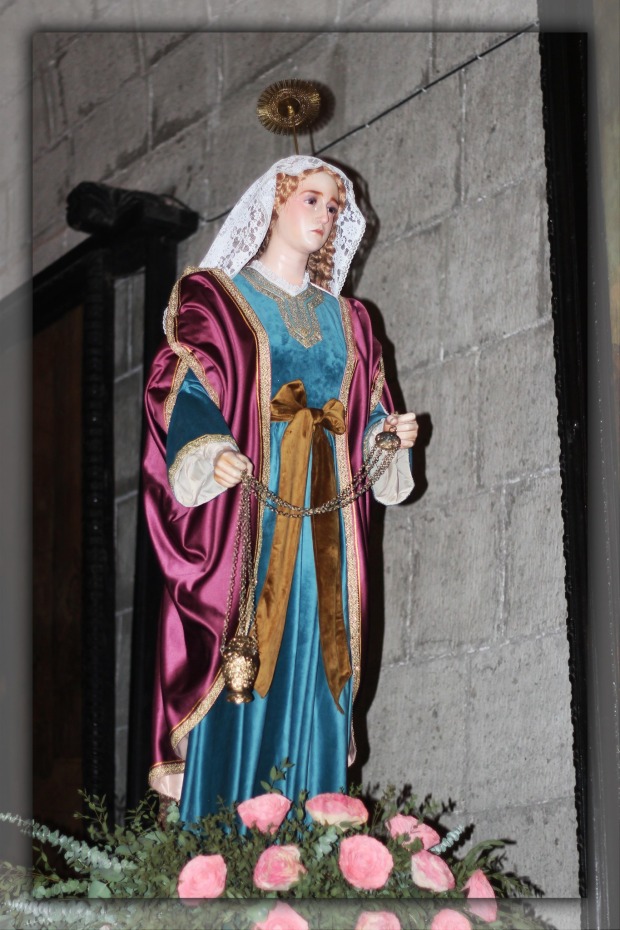
Depictions of St. Maria Salome often show her holding a thurible in Franciscan parishes, symbolizing her role in preparing the body of Jesus for burial and offering her sons to serve in Jesus’ ministry. In Augustinian parishes, she is typically portrayed holding a broom, alluding to her preparation for Jesus’ burial.
Santa Juana de Cuza
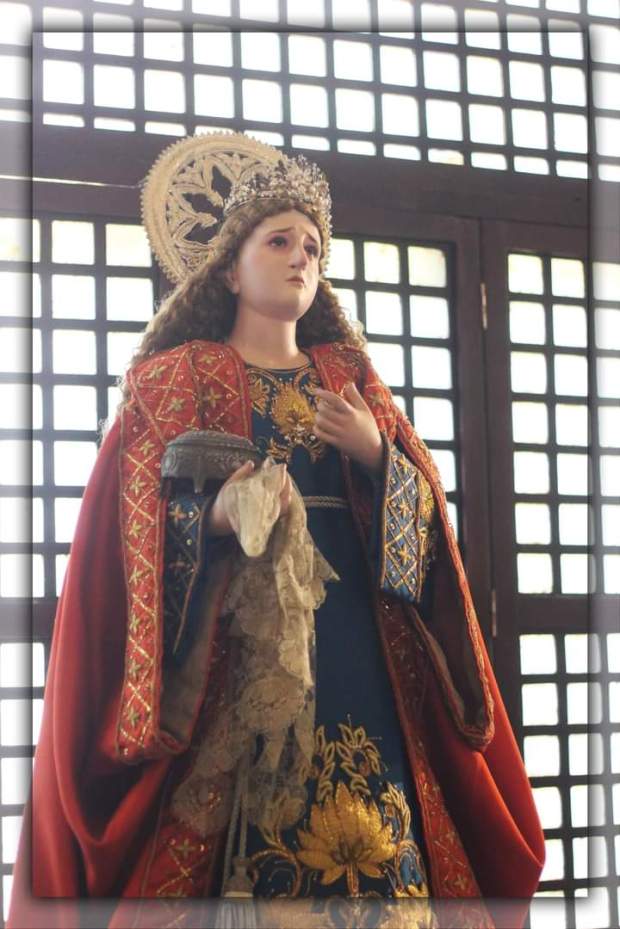
Feast: May 24
Iconography: Treasure box or a bag of coins
St. Joanna, the spouse of Chuza, was a female disciple of Jesus Christ. According to the Gospel of Luke, she was one of the women who followed Jesus and provided support to his ministry. She was also one of the women who went to the tomb on the morning of the resurrection and found that Jesus had risen from the dead.
Santa Maria Magdalena

Feast: July 22
Iconography: alabaster
St. Mary Magdalene, one of the followers of Jesus, made contributions for the needs of Jesus and his apostles. For a long time, it was believed that she was the woman who had been possessed by seven demons and whom Jesus had exorcised. However, the claim that she was a prostitute has been disputed. She was present at the crucifixion and death of Jesus. But her most significant role was as the first witness to the Resurrection and the first person to be sent by Jesus after his rising. As a result, she became known as “the Apostle to the Apostles.”
San Juan Evangelista

Feast: December 27
Iconography: quill, eagle
St. John, also known as “The Beloved,” was one of the twelve apostles of Jesus and the brother of St. James the Great. He was a part of Jesus’ inner circle and is believed to be the Beloved Disciple. St. John remained with Jesus until his death on the cross and took care of the Blessed Virgin Mary. He wrote five books in the New Testament, including his Gospel, three Epistles, and the Book of Revelation. Therefore, he is often depicted with a quill or book. Unlike other apostles who were martyred, St. John died a natural death, and he is the only apostle who remained with Jesus until death.
He is usually portrayed beardless as per the tradition that he was the youngest apostle. The eagle symbolizes the soaring theology that begins his Gospel. By tradition, he is the last Apostle in the procession for he is the only one who witnessed the crucifixion of Our Lord and accompanied the Virgin throughout the ordeal.
Mater Dolorosa

Feast: September 15, Viernes de Dolores (Friday before Palm Sunday)
Iconography: Heart pierced with Seven (or one) daggers
The Church honors Mary as the Mother of Sorrows or Mater Dolorosa. The title commemorates the sorrow that Mary experienced during her cooperation in the Suffering and Death of Our Lord Jesus Christ. seeing her own Son suffer and die on the cross. The daggers on her heart represent her seven sorrows or the seven sorrowing events in her life in allusion to the prophecy of Simeon to her: “Behold, this child is destined for the fall and rise of many in Israel, and to be a sign that will be contradicted and you yourself a sword will pierce.”

The Dolorosa is one of the most important images in the Holy Week processions due to her presence in the Viernes de Dolores rites, Estacion General, Via Crucis, the Good Friday processions, and the Procesion del Silencio to accompany the Virgin in her solitude and sorrow on the night of the first Good Friday.
Santo Entierro
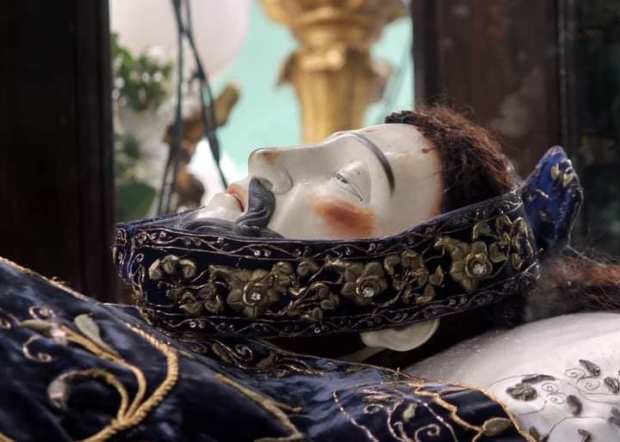
The last image of the Good Friday Procession is the image of the Santo Entierro (also known as the Santo Sepulcro) – the Dead Christ. Although it is the image of the dead Christ, his symbols of divinity are still depicted in this image with the presence of Tres Potencias attached to his head and having a serene countenance, waiting for his resurrection three days later. The Santo Entierro teaches us that death which was then the result of our sins became our passageway to our eternal reward when Christ rose from the dead and broke death’s original purpose.
The cult of the Santo Entierro in the Philippines is one of the most popular along with that of the Santo Niño and the Nazareno as evident with the shrines dedicated to the Dead Christ in Manila, Laguna, and Pampanga, beelines in parishes to venerate the Santo Entierro that is enshrined and the faithful visiting the chapels of camareros of the Good Friday Santo Entierro. In some parts of Luzon and Visayas, there were rites in honor of the Dead Christ that somehow harken back to Pre-Colonial times that still persist to this day.
Reflections on Holy Week Processions in the Modern world

For centuries, Holy Week processions have been a significant tradition in the Catholic Philippines. While these processions may appear antiquated to modern man, they remain relevant in the modern world.
For many people, Holy Week processions provide an opportunity to connect with their faith and reflect on the significance of Our Lord Jesus Christ’s sacrifice. They serve as a reminder of the importance of principles such as humility, compassion, and selflessness, which are as essential today as they were centuries ago.
Holy Week processions can bring communities together. In an increasingly fragmented society, these processions convey a sense of solidarity and togetherness. They also commemorate cultural heritage and community spirit. As participants join together to respect their common values and traditions, they draw people together and build a sense of togetherness.

Finally, Holy Week processions can serve as a reminder of the value of selflessness and sacrifice. They remind us of Jesus Christ’s ultimate sacrifice and challenge us to consider how we may be more unselfish in our own lives.
In conclusion, while Holy Week processions may be steeped in tradition, they still hold relevance in the modern world. They provide an opportunity for individuals to connect with their faith, bring communities together, and remind us of the importance of sacrifice and selflessness.
References:
Carabeo, Andre Josef, “Dissipet Tenebras: A Meditative Lenten Journey Featuring Forty Holy Week Processional Images”, St. Pauls Philippines, Makati City, 2023.
Cordero-Fernando, Gilda & Zialcita, Fernando, “Cuaresma”, The Bookmark, Inc., Makati City, 2001.
Diwa, Genaro, “On the Identity between Sta. Maria Jacobe and Sta. Maria Cleofe” Catholic Bishops Conference of the Philippines Episcopal Commission on Liturgy, Manila, 2012.
delos Reyes, Michael, “Holy Week and Easter Processions: A Liturgico-pastoral Guide”, Claretian Communications Foundation, Inc., Quezon City, 2015.
delos Reyes, Michael, “Prusisyon: Paghahanda at Pagdiriwang – Pinaunlad na Edisyon”, Claretian Communications Foundation, Inc., Quezon City, 2018.
“La Sagrada Pasion y Esperanza Nuestra”, Hermandad y Cofradía de la Sagrada Pasión y Esperanza Macarena, Parish of La Purisima Concepcion, Santa Maria, Bulacan, 2011.
“Mga Pagdiriwang sa Kwaresma at mga Mahal na Araw” [Sixth Edition], Komisyon ng Liturhiya, Diyosesis ng San Pablo, The Roman Catholic Diocese of San Pablo, San Pablo, Laguna, 2022.
Nacorda, Clodoveo, “Kwaresmang Pinoy: Main Characters and Popular Filipino Piety”, Retrieved from https://youtu.be/GEgHSFp_LTk on March 30, 2023.
Valera, Andres, “Banal na Triduo: Ang Tatlong Araw na Pagdiriwang ng Pagpapakasakit at Pagkabuhay ng Panginoon”, [Fourth Edition], Diocesan Liturgical Commission Diocese of Malolos, Malolos, Bulacan, 2019.
Photos:
Arnold, Carl
Badulis, Jay-ar
Congregacion del Santo Cristo
Daquioag, Michael of Buen Viaje PH
de la Cruz, Jefferson
Geronimo, Raymond Christian Halili
Gozon, Jossen
Heirs of Amado and Asunción Tamayo
Hermandad de Sagrada Pasion y Maria Santisima de la Esperanza Macarena Filipina
Loiz, Vincent Galileo
Malabanan, James Benedict
Naval, Wilfred Jason of My Religious Journey
Reyes, Arnold for Bordados de Manila
Santos, John Valenzuela
Tolentino, Thom of Photographia et Religiosus
Victorino, Gabriel Cedrick of Desamparats PH
+AM+DG+ +AMPSPC+


